Earlier this month I had the pleasure of participating in Camp Schramsberg, a two day, education filled experience encompassing all aspects of sparkling wine production at Schramsberg Vineyards, aka "America's House of Sparkling Wine." This very special "camp" is offered twice a year, in the Spring and again in the Fall, to both consumers as well as individuals in the trade, and offers all attendees the opportunity to participate in and observe the seasonal happenings at the winery. September marks the beginning of harvest, an exciting time to be in California wine country. Before we embarked our two day adventure, campers were welcomed with dinner among the vineyards at Schramsberg in Calistoga, about 25 miles north of Napa.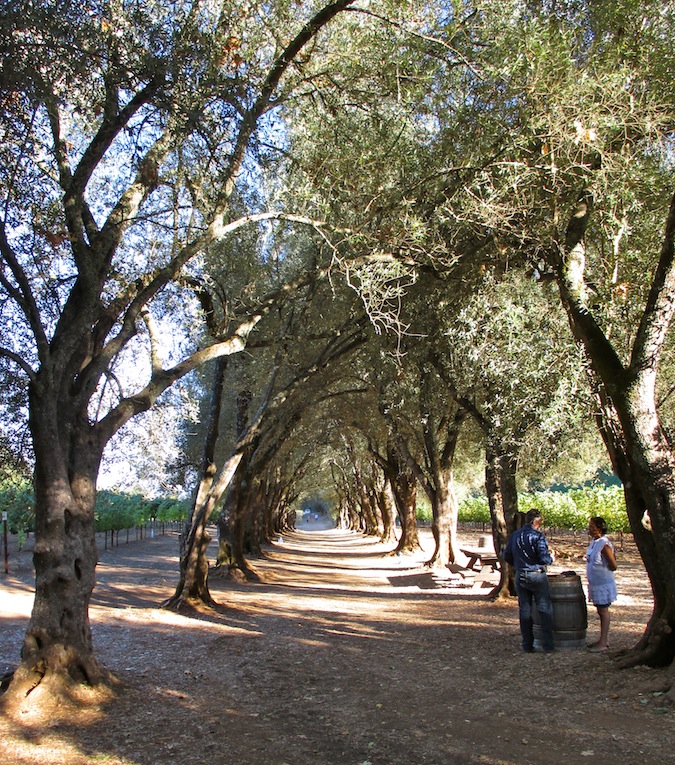 We arrived at the winery at sunset and followed an inviting path under a canopy of olive trees to a clearing where we were greeted by Hugh Davies, President and CEO of Schramsberg Vineyards. The welcome dinner took place in the J. Davies vineyard, named in honor of Hugh's father, Jack Davies, patriarch of the family who, with his wife Jamie, put Schramsberg Vineyards on the map as a world class sparkling wine house and ran it for over thirty years. The J. Davies vineyard is planted entirely to Cabernet Sauvignon from which the eponymous wine is made. We also had the pleasure of meeting Hugh's wife Monique (the two were married in this vineyard) as well as their three children who climbed trees and explored the vineyard while we sipped bubbly and got to know one another.We were welcomed with chilled flutes of Schramsberg's two single vineyard sparklers, the '08 Hyde Vineyards Napa Valley Carneros Brut and the '08 Jones Vineyard Napa Valley Carneros Brut. These delightful wines were perfect for quenching my thirst following a cross country flight and two hour drive up to wine country from San Francisco. They also paired beautifully with a variety of delicious hors d'oeuvres including Beef Tartare, Wild Salmon Crostini and, my personal favorite, Duck Confit "Chicken" Wings which provided a nice contrast to the crisp, sparkling wines. During the dinner we also had the chance to meet other key players at Schramsberg including Sparkling winemaker Keith Hock; Still Winemaker, Sean Thompson and Chef and Instructor for the weekend, the delightful Holly Peterson.
We arrived at the winery at sunset and followed an inviting path under a canopy of olive trees to a clearing where we were greeted by Hugh Davies, President and CEO of Schramsberg Vineyards. The welcome dinner took place in the J. Davies vineyard, named in honor of Hugh's father, Jack Davies, patriarch of the family who, with his wife Jamie, put Schramsberg Vineyards on the map as a world class sparkling wine house and ran it for over thirty years. The J. Davies vineyard is planted entirely to Cabernet Sauvignon from which the eponymous wine is made. We also had the pleasure of meeting Hugh's wife Monique (the two were married in this vineyard) as well as their three children who climbed trees and explored the vineyard while we sipped bubbly and got to know one another.We were welcomed with chilled flutes of Schramsberg's two single vineyard sparklers, the '08 Hyde Vineyards Napa Valley Carneros Brut and the '08 Jones Vineyard Napa Valley Carneros Brut. These delightful wines were perfect for quenching my thirst following a cross country flight and two hour drive up to wine country from San Francisco. They also paired beautifully with a variety of delicious hors d'oeuvres including Beef Tartare, Wild Salmon Crostini and, my personal favorite, Duck Confit "Chicken" Wings which provided a nice contrast to the crisp, sparkling wines. During the dinner we also had the chance to meet other key players at Schramsberg including Sparkling winemaker Keith Hock; Still Winemaker, Sean Thompson and Chef and Instructor for the weekend, the delightful Holly Peterson.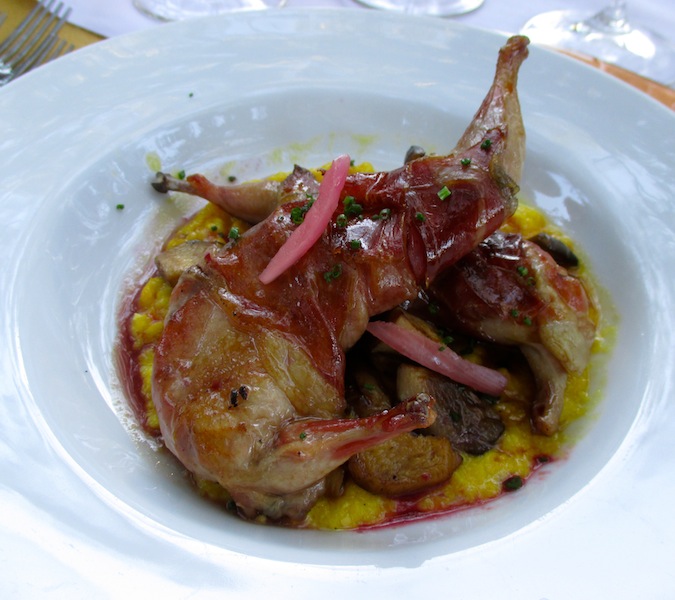 Once we were seated for dinner, the wine focus shifted to Schramsberg's still red wines, relatively new additions to the portfolio of this predominantly sparkling wine house. What better way to introduce them than to pair them with a delicious menu? The first course consisted of a beautiful La Quercia Speck Wrapped Quail with Creamed Corn, Trumpet Mushrooms and Pinot Noir Verjus paired with a duo of 2010 Davies single vineyard Pinot Noirs from the Londer Vineyard in Anderson Valley and the Nobles Vineyard from Sonoma Coast.The 2010 vintage represents the second vintage of the winery's still wines made from Pinot Noir. Both wines were lovely yet different: the Londer Vineyard Pinot was characterized by notes of ripe red and black fruit, licorice and spice while the Nobles Pinot exhibited notes of dried fruit and earth as well as firm tannins. Both wines paired nicely with the quail though I was partial to the Londer Vineyard Pinot with its plusher fruit and mild tannins.The main course of our vineyard dinner was a carnivore's dream featuring two different styles of succulent ribs: Slow Smoked Long Meadow Ranch Beef Ribs and Slow Smoked St. Louis Ribs with Memphis-style Barbeque Sauce, which ignited a rib rivalry among the Campers! I have to admit both types of ribs were mouth-wateringly delicious and paired well with the fruity and approachable 2009 J. Davies Cabernet Sauvignon from the Diamond Mountain District. My tablemates even made an agreement early on in the meal that it was perfectly acceptable to use our hands in lieu of utensils so we were all in virtual Hog Heaven - pun intended!
Once we were seated for dinner, the wine focus shifted to Schramsberg's still red wines, relatively new additions to the portfolio of this predominantly sparkling wine house. What better way to introduce them than to pair them with a delicious menu? The first course consisted of a beautiful La Quercia Speck Wrapped Quail with Creamed Corn, Trumpet Mushrooms and Pinot Noir Verjus paired with a duo of 2010 Davies single vineyard Pinot Noirs from the Londer Vineyard in Anderson Valley and the Nobles Vineyard from Sonoma Coast.The 2010 vintage represents the second vintage of the winery's still wines made from Pinot Noir. Both wines were lovely yet different: the Londer Vineyard Pinot was characterized by notes of ripe red and black fruit, licorice and spice while the Nobles Pinot exhibited notes of dried fruit and earth as well as firm tannins. Both wines paired nicely with the quail though I was partial to the Londer Vineyard Pinot with its plusher fruit and mild tannins.The main course of our vineyard dinner was a carnivore's dream featuring two different styles of succulent ribs: Slow Smoked Long Meadow Ranch Beef Ribs and Slow Smoked St. Louis Ribs with Memphis-style Barbeque Sauce, which ignited a rib rivalry among the Campers! I have to admit both types of ribs were mouth-wateringly delicious and paired well with the fruity and approachable 2009 J. Davies Cabernet Sauvignon from the Diamond Mountain District. My tablemates even made an agreement early on in the meal that it was perfectly acceptable to use our hands in lieu of utensils so we were all in virtual Hog Heaven - pun intended!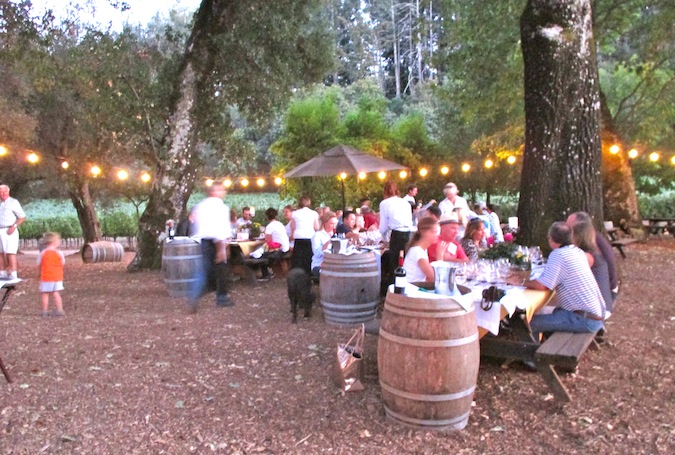 After our BBQ feast, we were treated to a cheese course featuring Fiscalini Cheddar, Point Reyes Toma and Shepherdista cheeses accompanied by black mission figs, apples and almonds. It was difficult not to consume all the delicious food and wine over the course of the evening, however, upon advice from Matt Levy, our fearless Camp Counselor, we were careful not to indulge too much in anticipation of the early morning ahead - buses were scheduled to leave Meadowood at 7:30am sharp. A good night's sleep was mandatory!
After our BBQ feast, we were treated to a cheese course featuring Fiscalini Cheddar, Point Reyes Toma and Shepherdista cheeses accompanied by black mission figs, apples and almonds. It was difficult not to consume all the delicious food and wine over the course of the evening, however, upon advice from Matt Levy, our fearless Camp Counselor, we were careful not to indulge too much in anticipation of the early morning ahead - buses were scheduled to leave Meadowood at 7:30am sharp. A good night's sleep was mandatory!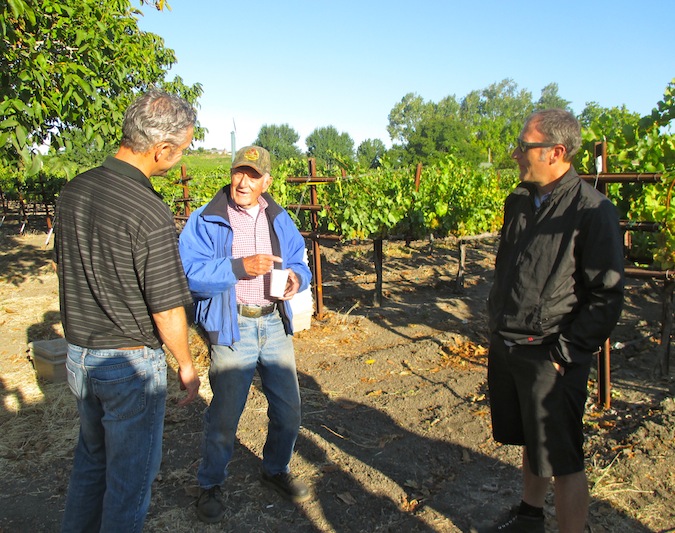 The next morning, we boarded the "Schramsberg Express" bus and headed towards Carneros. We were very fortunate to have Hugh Davies himself as our tour guide and enjoyed a 45-minute narrated drive to our destination getting the inside scoop on the beautiful landscape that unfolded before us. Highlights included the impact of the recent heat spike and its effect on various microclimates; who's Zinfandel vines were just being replanted; and the details of Jack and Jamie Davies' foray into the Cognac business with Remy Martin in the early days.Before we knew it we arrived at the Tognetti Vineyard where we were greeted by none other than Jack Tognetti himself, one of the spriest 90-something-year-olds I've ever met. He was joined by Schramsberg sparkling winemaker Keith Hock and Jaime, a Vineyard Manager who has been with Schramsberg since 1968!Jack Tognetti worked in the steamship business for twenty years but always thought of himself as a "farmer at heart." Tognetti purchased his vineyard and started planting Chardonnay grapes in 1980 and while he initially sold his grapes to the Swanson family, since 1998 he's been selling his Chardonnay exclusively to Schramsberg.He describes the climate as "cool and consistent: perfect for growing grapes for sparkling wine, " and about his working relationship with Schramsberg, "I try to give them nice fruit otherwise they bitch!" The vineyard produces approximately 80 tons of fruit consisting of a variety of clones including Monticello, the one we would be harvesting today. Beneath the vineyard soil is a pan of clay which is good at retaining water, making for very vigorous vines. The vines are grown on a quadrilateral trellis system and the grapes are picked between 17-21 Brix, the ideal range according to Keith Hock who gets a call from Tognetti at the appropriate time saying, "Keith, my damned vines are ready - pick 'em!"
The next morning, we boarded the "Schramsberg Express" bus and headed towards Carneros. We were very fortunate to have Hugh Davies himself as our tour guide and enjoyed a 45-minute narrated drive to our destination getting the inside scoop on the beautiful landscape that unfolded before us. Highlights included the impact of the recent heat spike and its effect on various microclimates; who's Zinfandel vines were just being replanted; and the details of Jack and Jamie Davies' foray into the Cognac business with Remy Martin in the early days.Before we knew it we arrived at the Tognetti Vineyard where we were greeted by none other than Jack Tognetti himself, one of the spriest 90-something-year-olds I've ever met. He was joined by Schramsberg sparkling winemaker Keith Hock and Jaime, a Vineyard Manager who has been with Schramsberg since 1968!Jack Tognetti worked in the steamship business for twenty years but always thought of himself as a "farmer at heart." Tognetti purchased his vineyard and started planting Chardonnay grapes in 1980 and while he initially sold his grapes to the Swanson family, since 1998 he's been selling his Chardonnay exclusively to Schramsberg.He describes the climate as "cool and consistent: perfect for growing grapes for sparkling wine, " and about his working relationship with Schramsberg, "I try to give them nice fruit otherwise they bitch!" The vineyard produces approximately 80 tons of fruit consisting of a variety of clones including Monticello, the one we would be harvesting today. Beneath the vineyard soil is a pan of clay which is good at retaining water, making for very vigorous vines. The vines are grown on a quadrilateral trellis system and the grapes are picked between 17-21 Brix, the ideal range according to Keith Hock who gets a call from Tognetti at the appropriate time saying, "Keith, my damned vines are ready - pick 'em!"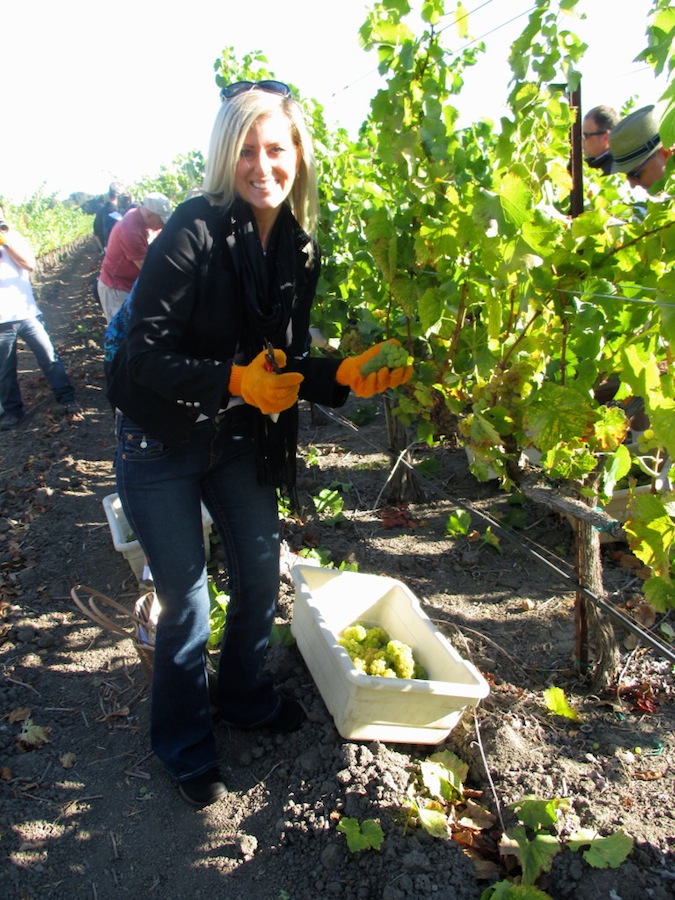 After our introduction to Jack and his vineyard we donned our gloves and grabbed our secateurs and headed down the vineyard rows, plastic bins in hand. Our challenge was to harvest as close to one ton of fruit as we could so everyone quickly got to work - no pressure!While initially unsure of exactly where to snip each cluster of grapes, with some instruction from Keith and Hugh I found my rhythm and was soon harvesting away. The clusters were large and heavy and the ripe Chardonnay grapes tasted like candy. Before I knew it, my bin was full and I just kept on harvesting until I had completed three whole bins. Everyone was really getting into the task at hand and before we knew it, all the grapes were harvested. The next step was to take the grapes we had freshly harvested back to the winery for pressing.
After our introduction to Jack and his vineyard we donned our gloves and grabbed our secateurs and headed down the vineyard rows, plastic bins in hand. Our challenge was to harvest as close to one ton of fruit as we could so everyone quickly got to work - no pressure!While initially unsure of exactly where to snip each cluster of grapes, with some instruction from Keith and Hugh I found my rhythm and was soon harvesting away. The clusters were large and heavy and the ripe Chardonnay grapes tasted like candy. Before I knew it, my bin was full and I just kept on harvesting until I had completed three whole bins. Everyone was really getting into the task at hand and before we knew it, all the grapes were harvested. The next step was to take the grapes we had freshly harvested back to the winery for pressing.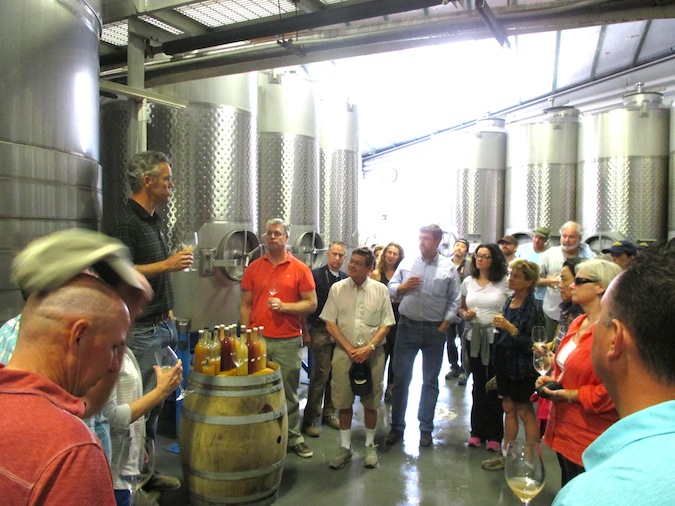 Back at Schramsberg, fueled by our success in the vineyard as well as the coffee and doughnut holes on the bus ride back, we were excited to taste the fruits of our labor. In addition to the freshly pressed juice from the Tognetti vineyard, which was sweet and grapey, we also tasted through a variety of wines in various states of fermentation.The samples in the bottles resembled murky, opaque lemonade, orange or cranberry juice and tasted like apples and citrus with yeasty overtones which we happily spat out onto the concrete floor. These wines were definitely not what you'd want to drink a whole glass of but a necessary step along the way to becoming a fabulous Schramsberg sparkler.First we tasted samples from the tanks and then from barrel, the latter being more bitter and difficult to tolerate and while unpleasant tasting, it was very interesting to experience the various stages of the fermentation process and experience first-hand the evolution of sparkling wine. Following the vinous assault on our palates, we were bussed off to Meadowood for lunch - the timing couldn't have been more perfect!
Back at Schramsberg, fueled by our success in the vineyard as well as the coffee and doughnut holes on the bus ride back, we were excited to taste the fruits of our labor. In addition to the freshly pressed juice from the Tognetti vineyard, which was sweet and grapey, we also tasted through a variety of wines in various states of fermentation.The samples in the bottles resembled murky, opaque lemonade, orange or cranberry juice and tasted like apples and citrus with yeasty overtones which we happily spat out onto the concrete floor. These wines were definitely not what you'd want to drink a whole glass of but a necessary step along the way to becoming a fabulous Schramsberg sparkler.First we tasted samples from the tanks and then from barrel, the latter being more bitter and difficult to tolerate and while unpleasant tasting, it was very interesting to experience the various stages of the fermentation process and experience first-hand the evolution of sparkling wine. Following the vinous assault on our palates, we were bussed off to Meadowood for lunch - the timing couldn't have been more perfect!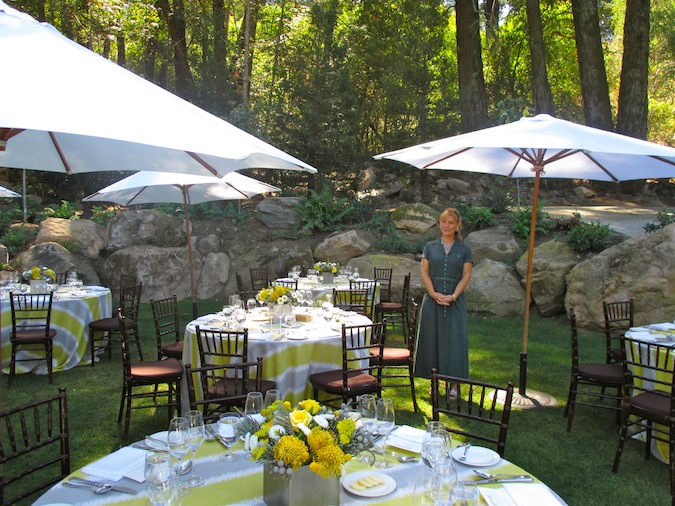 Waiting for us on the lawn at Meadowood was our Instructor for the rest of the afternoon, the delightful Holly Peterson, a renowned Chef who helped the Davies family conceive of and develop the Camp Schramsberg program 18 years ago.Peterson has quite an impressive resume including a degree in enology from the University of California, Davis and the Grand Diplome de Cuisine from the famed La Varenne Cooking School in France. She has shared her talent and passion for pairing food and wine in restaurants and venues around the world yet she and her family are very much a part of California wine history and community.Her father Richard Peterson is a California wine country pioneer and sister Heidi Peterson Barrett is a winemaker known for producing such well known California cult collectibles as Screaming Eagle, Dalla Valle and Paradigm to name a few.
Waiting for us on the lawn at Meadowood was our Instructor for the rest of the afternoon, the delightful Holly Peterson, a renowned Chef who helped the Davies family conceive of and develop the Camp Schramsberg program 18 years ago.Peterson has quite an impressive resume including a degree in enology from the University of California, Davis and the Grand Diplome de Cuisine from the famed La Varenne Cooking School in France. She has shared her talent and passion for pairing food and wine in restaurants and venues around the world yet she and her family are very much a part of California wine history and community.Her father Richard Peterson is a California wine country pioneer and sister Heidi Peterson Barrett is a winemaker known for producing such well known California cult collectibles as Screaming Eagle, Dalla Valle and Paradigm to name a few.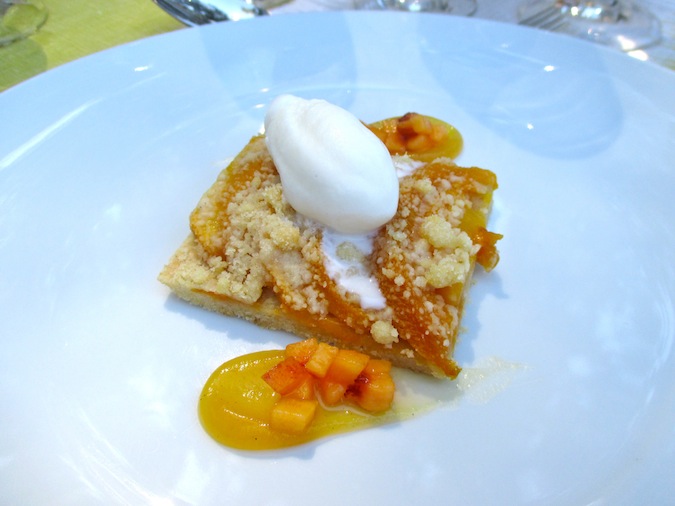 We sat down to a lovely three course lunch paired with Schramsberg's sparkling wines featuring Squash Consomme with Fresh Burrata, White Anchovies, Garden Herbs and Basil Blossoms paired with the 2005 J. Schram Rosé which continued to flow into the second course of Grilled Halibut with Roasted Baby Beets, Horseradish Creme Fraiche and Tempura Avocado. The rosé paired remarkably well with the various flavors and textures of the halibut dish especially the tempura avocado, the wine's natural acidity cutting through the rich, creamy texture. Our delightful lunch ended with one of my favorite pairings of the weekend: a Peach Cobbler with Anise Ice Cream paired with the 2008 Schramsberg Cremant Demi-Sec. The anise ice cream synergized with notes in the wine creating that elusive and oh so special 1+1=3 effect! Needless to say there's wasn't a crumb left on my plate.After our decadent, delicious lunch, we gathered around Peterson on the lawn as she taught us the art of sabrage, a technique for opening a bottle of Champagne using a sabre, a practice initially made famous by Napoleon who usually did so following a victory on the battlefield while on horseback. "The bottle consists of three components," Peterson instructed, "the two halves of the bottle and the collar, which sits on top of the neck of the bottle and holds the cork."She demonstrated the technique by holding a bottle of bubbly in one hand at a 45 degree angle with the seam facing up. Holding the sabre in the other hand, she ran the blade, tentatively at first, along the seam of the bottle then using enough force to hit the collar and cause the seam to "pop," shooting the collar off of the bottle in grand fashion with the cork still in it. Sounds easy enough, right? Actually it's not nearly as hard as it sounds or looks, you just need to "pop the seam," a phrase which would become our mantra as, one by one, each camper tried their hand at this age old tradition.
We sat down to a lovely three course lunch paired with Schramsberg's sparkling wines featuring Squash Consomme with Fresh Burrata, White Anchovies, Garden Herbs and Basil Blossoms paired with the 2005 J. Schram Rosé which continued to flow into the second course of Grilled Halibut with Roasted Baby Beets, Horseradish Creme Fraiche and Tempura Avocado. The rosé paired remarkably well with the various flavors and textures of the halibut dish especially the tempura avocado, the wine's natural acidity cutting through the rich, creamy texture. Our delightful lunch ended with one of my favorite pairings of the weekend: a Peach Cobbler with Anise Ice Cream paired with the 2008 Schramsberg Cremant Demi-Sec. The anise ice cream synergized with notes in the wine creating that elusive and oh so special 1+1=3 effect! Needless to say there's wasn't a crumb left on my plate.After our decadent, delicious lunch, we gathered around Peterson on the lawn as she taught us the art of sabrage, a technique for opening a bottle of Champagne using a sabre, a practice initially made famous by Napoleon who usually did so following a victory on the battlefield while on horseback. "The bottle consists of three components," Peterson instructed, "the two halves of the bottle and the collar, which sits on top of the neck of the bottle and holds the cork."She demonstrated the technique by holding a bottle of bubbly in one hand at a 45 degree angle with the seam facing up. Holding the sabre in the other hand, she ran the blade, tentatively at first, along the seam of the bottle then using enough force to hit the collar and cause the seam to "pop," shooting the collar off of the bottle in grand fashion with the cork still in it. Sounds easy enough, right? Actually it's not nearly as hard as it sounds or looks, you just need to "pop the seam," a phrase which would become our mantra as, one by one, each camper tried their hand at this age old tradition.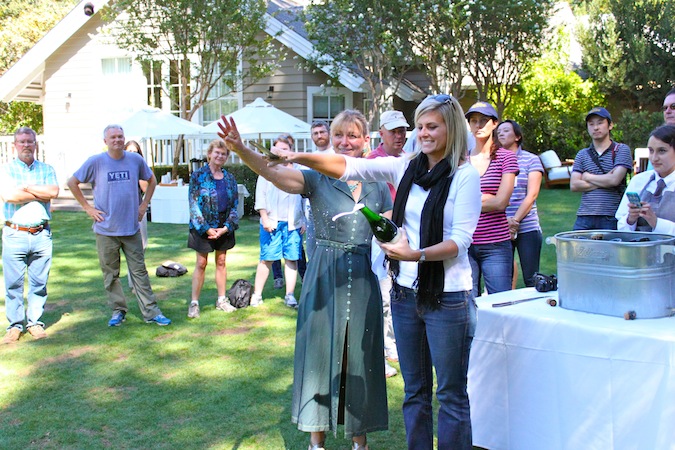 Peterson offered us two weapons of choice to practice our sabering skills, a Laguiole Champagne sabre as well as a genuine antique sabre she procured from a French vintage shop that looked as if it may have belonged to Napoleon himself! As a practitioner of sabrage with my own Laguiole sabre at home, I looked forward to using the vintage saber when it came time to decapitate my bottle.It was quite heavy and much larger than the sabre I was used to using and as I grasped it I had a fleeting feeling of being on the battlefield then realized I'd much rather be on the lawn at Meadowood about to open a bottle of sparkling wine. The larger sabre made the process much easier due to its weight and momentum and before I knew it, the cork was shooting across the lawn and I was victorious!
Peterson offered us two weapons of choice to practice our sabering skills, a Laguiole Champagne sabre as well as a genuine antique sabre she procured from a French vintage shop that looked as if it may have belonged to Napoleon himself! As a practitioner of sabrage with my own Laguiole sabre at home, I looked forward to using the vintage saber when it came time to decapitate my bottle.It was quite heavy and much larger than the sabre I was used to using and as I grasped it I had a fleeting feeling of being on the battlefield then realized I'd much rather be on the lawn at Meadowood about to open a bottle of sparkling wine. The larger sabre made the process much easier due to its weight and momentum and before I knew it, the cork was shooting across the lawn and I was victorious!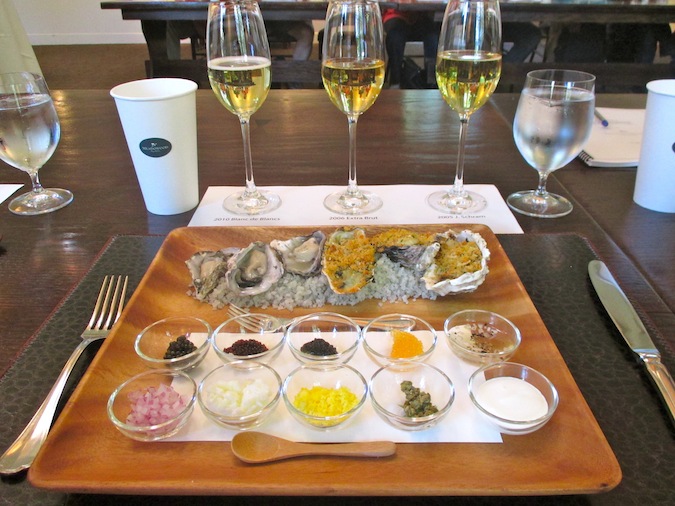 We finished the day with a lesson on pairing sparkling wine with food, focusing on "The Classics." On the tasting mats before us were three glasses of Schramsberg bubbly: the 2010 Blanc de Blancs, 2006 Extra Brut and the 2005 J. Schram. Peterson guided us through a tasting of the sparkling wines and we acquainted ourselves with the nuances of each one before any food was introduced. After this arduous task we were presented with a platter of delightful selections from the sea to pair with the sparklers including raw oysters, Oysters Rockefeller and a selection of caviar and associated accoutrements.Over the remainder of the day we experimented with various pairing combinations, challenging some conventionally held beliefs and discovering some new favorites. The raw oysters (Miyagi oysters from the Pacific Northwest) with mignonette were brilliant paired with the 2010 Blanc de Blancs as one might expect. The Oyster Rockefeller on the other hand paired best with the 2005 J. Schram, the Schramsberg tête de cuvée, with its rich, nutty profile. The caviar pairings also revealed some surprises such as the significant difference the toppings make. Truffled Tiger-Eye Whitefish Roe topped with egg yolk was utterly delicious when paired with the 2006 Extra Brut; however, when the yolk was swapped for egg white the result was nowhere near as pleasing. By the end of the seminar we had experimented with a variety of options and learned a lot about the nuances of creating the "perfect pairing."As our first day of Camp drew to a close, we were blissfully weary from all the harvesting, sabrage and sparkling wine and food pairing (can you hear the violins?). The day was not entirely done, however, because just a few short hours after our last class was over the Schramsberg Library Wine Dinner would begin and you know there's no way I was going to miss that! Stay tuned for "Part Two" of my Camp Schramsberg adventures.Cheers,
We finished the day with a lesson on pairing sparkling wine with food, focusing on "The Classics." On the tasting mats before us were three glasses of Schramsberg bubbly: the 2010 Blanc de Blancs, 2006 Extra Brut and the 2005 J. Schram. Peterson guided us through a tasting of the sparkling wines and we acquainted ourselves with the nuances of each one before any food was introduced. After this arduous task we were presented with a platter of delightful selections from the sea to pair with the sparklers including raw oysters, Oysters Rockefeller and a selection of caviar and associated accoutrements.Over the remainder of the day we experimented with various pairing combinations, challenging some conventionally held beliefs and discovering some new favorites. The raw oysters (Miyagi oysters from the Pacific Northwest) with mignonette were brilliant paired with the 2010 Blanc de Blancs as one might expect. The Oyster Rockefeller on the other hand paired best with the 2005 J. Schram, the Schramsberg tête de cuvée, with its rich, nutty profile. The caviar pairings also revealed some surprises such as the significant difference the toppings make. Truffled Tiger-Eye Whitefish Roe topped with egg yolk was utterly delicious when paired with the 2006 Extra Brut; however, when the yolk was swapped for egg white the result was nowhere near as pleasing. By the end of the seminar we had experimented with a variety of options and learned a lot about the nuances of creating the "perfect pairing."As our first day of Camp drew to a close, we were blissfully weary from all the harvesting, sabrage and sparkling wine and food pairing (can you hear the violins?). The day was not entirely done, however, because just a few short hours after our last class was over the Schramsberg Library Wine Dinner would begin and you know there's no way I was going to miss that! Stay tuned for "Part Two" of my Camp Schramsberg adventures.Cheers,

Earlier this month I had the pleasure of participating in Camp Schramsberg, a two day, education filled experience encompassing all aspects of sparkling wine production at Schramsberg Vineyards, aka “America’s House of Sparkling Wine.” This very special “camp” is offered twice a year, in the Spring and again in the Fall, to both consumers as well as individuals in the trade, and offers all attendees the opportunity to participate in and observe the seasonal happenings at the winery. September marks the beginning of harvest, an exciting time to be in California wine country. Before we embarked our two day adventure, campers were welcomed with dinner among the vineyards at Schramsberg in Calistoga, about 25 miles north of Napa.

We arrived at the winery at sunset and followed an inviting path under a canopy of olive trees to a clearing where we were greeted by Hugh Davies, President and CEO of Schramsberg Vineyards. The welcome dinner took place in the J. Davies vineyard, named in honor of Hugh’s father, Jack Davies, patriarch of the family who, with his wife Jamie, put Schramsberg Vineyards on the map as a world class sparkling wine house and ran it for over thirty years. The J. Davies vineyard is planted entirely to Cabernet Sauvignon from which the eponymous wine is made. We also had the pleasure of meeting Hugh’s wife Monique (the two were married in this vineyard) as well as their three children who climbed trees and explored the vineyard while we sipped bubbly and got to know one another.
We were welcomed with chilled flutes of Schramsberg’s two single vineyard sparklers, the ’08 Hyde Vineyards Napa Valley Carneros Brut and the ’08 Jones Vineyard Napa Valley Carneros Brut. These delightful wines were perfect for quenching my thirst following a cross country flight and two hour drive up to wine country from San Francisco. They also paired beautifully with a variety of delicious hors d’oeuvres including Beef Tartare, Wild Salmon Crostini and, my personal favorite, Duck Confit “Chicken” Wings which provided a nice contrast to the crisp, sparkling wines. During the dinner we also had the chance to meet other key players at Schramsberg including Sparkling winemaker Keith Hock; Still Winemaker, Sean Thompson and Chef and Instructor for the weekend, the delightful Holly Peterson.

Once we were seated for dinner, the wine focus shifted to Schramsberg’s still red wines, relatively new additions to the portfolio of this predominantly sparkling wine house. What better way to introduce them than to pair them with a delicious menu? The first course consisted of a beautiful La Quercia Speck Wrapped Quail with Creamed Corn, Trumpet Mushrooms and Pinot Noir Verjus paired with a duo of 2010 Davies single vineyard Pinot Noirs from the Londer Vineyard in Anderson Valley and the Nobles Vineyard from Sonoma Coast. The 2010 vintage represents the second vintage of the winery’s still wines made from Pinot Noir. Both wines were lovely yet different: the Londer Vineyard Pinot was characterized by notes of ripe red and black fruit, licorice and spice while the Nobles Pinot exhibited notes of dried fruit and earth as well as firm tannins. Both wines paired nicely with the quail though I was partial to the Londer Vineyard Pinot with its plusher fruit and mild tannins.
The main course of our vineyard dinner was a carnivore’s dream featuring two different styles of succulent ribs: Slow Smoked Long Meadow Ranch Beef Ribs and Slow Smoked St. Louis Ribs with Memphis-style Barbeque Sauce, which ignited a rib rivalry among the Campers! I have to admit both types of ribs were mouth-wateringly delicious and paired well with the fruity and approachable 2009 J. Davies Cabernet Sauvignon from the Diamond Mountain District. My tablemates even made an agreement early on in the meal that it was perfectly acceptable to use our hands in lieu of utensils so we were all in virtual Hog Heaven – pun intended!

After our BBQ feast, we were treated to a cheese course featuring Fiscalini Cheddar, Point Reyes Toma and Shepherdista cheeses accompanied by black mission figs, apples and almonds. It was difficult not to consume all the delicious food and wine over the course of the evening, however, upon advice from Matt Levy, our fearless Camp Counselor, we were careful not to indulge too much in anticipation of the early morning ahead – buses were scheduled to leave Meadowood at 7:30am sharp. A good night’s sleep was mandatory!

The next morning, we boarded the “Schramsberg Express” bus and headed towards Carneros. We were very fortunate to have Hugh Davies himself as our tour guide and enjoyed a 45-minute narrated drive to our destination getting the inside scoop on the beautiful landscape that unfolded before us. Highlights included the impact of the recent heat spike and its effect on various microclimates; who’s Zinfandel vines were just being replanted; and the details of Jack and Jamie Davies’ foray into the Cognac business with Remy Martin in the early days. Before we knew it we arrived at the Tognetti Vineyard where we were greeted by none other than Jack Tognetti himself, one of the spriest 9o-something-year-olds I’ve ever met. He was joined by Schramsberg sparkling winemaker Keith Hock and Jaime, a Vineyard Manager who has been with Schramsberg since 1968!
Jack Tognetti worked in the steamship business for twenty years but always thought of himself as a “farmer at heart.” Tognetti purchased his vineyard and started planting Chardonnay grapes in 1980 and while he initially sold his grapes to the Swanson family, since 1998 he’s been selling his Chardonnay exclusively to Schramsberg. He describes the climate as “cool and consistent: perfect for growing grapes for sparkling wine, ” and about his working relationship with Schramsberg, “I try to give them nice fruit otherwise they bitch!” The vineyard produces approximately 80 tons of fruit consisting of a variety of clones including Monticello, the one we would be harvesting today. Beneath the vineyard soil is a pan of clay which is good at retaining water, making for very vigorous vines. The vines are grown on a quadrilateral trellis system and the grapes are picked between 17-21 Brix, the ideal range according to Keith Hock who gets a call from Tognetti at the appropriate time saying, “Keith, my damned vines are ready – pick ‘em!”

After our introduction to Jack and his vineyard we donned our gloves and grabbed our secateurs and headed down the vineyard rows, plastic bins in hand. Our challenge was to harvest as close to one ton of fruit as we could so everyone quickly got to work – no pressure! While initially unsure of exactly where to snip each cluster of grapes, with some instruction from Keith and Hugh I found my rhythm and was soon harvesting away. The clusters were large and heavy and the ripe Chardonnay grapes tasted like candy. Before I knew it, my bin was full and I just kept on harvesting until I had completed three whole bins. Everyone was really getting into the task at hand and before we knew it, all the grapes were harvested. The next step was to take the grapes we had freshly harvested back to the winery for pressing.

Back at Schramsberg, fueled by our success in the vineyard as well as the coffee and doughnut holes on the bus ride back, we were excited to taste the fruits of our labor. In addition to the freshly pressed juice from the Tognetti vineyard, which was sweet and grapey, we also tasted through a variety of wines in various states of fermentation. The samples in the bottles resembled murky, opaque lemonade, orange or cranberry juice and tasted like apples and citrus with yeasty overtones which we happily spat out onto the concrete floor. These wines were definitely not what you’d want to drink a whole glass of but a necessary step along the way to becoming a fabulous Schramsberg sparkler. First we tasted samples from the tanks and then from barrel, the latter being more bitter and difficult to tolerate and while unpleasant tasting, it was very interesting to experience the various stages of the fermentation process and experience first-hand the evolution of sparkling wine. Following the vinous assault on our palates, we were bussed off to Meadowood for lunch – the timing couldn’t have been more perfect!

Waiting for us on the lawn at Meadowood was our Instructor for the rest of the afternoon, the delightful Holly Peterson, a renowned Chef who helped the Davies family conceive of and develop the Camp Schramsberg program 18 years ago. Peterson has quite an impressive resume including a degree in enology from the University of California, Davis and the Grand Diplome de Cuisine from the famed La Varenne Cooking School in France. She has shared her talent and passion for pairing food and wine in restaurants and venues around the world yet she and her family are very much a part of California wine history and community. Her father Richard Peterson is a California wine country pioneer and sister Heidi Peterson Barrett is a winemaker known for producing such well known California cult collectibles as Screaming Eagle, Dalla Valle and Paradigm to name a few.

We sat down to a lovely three course lunch paired with Schramsberg’s sparkling wines featuring Squash Consomme with Fresh Burrata, White Anchovies, Garden Herbs and Basil Blossoms paired with the 2005 J. Schram Rosé which continued to flow into the second course of Grilled Halibut with Roasted Baby Beets, Horseradish Creme Fraiche and Tempura Avocado. The rosé paired remarkably well with the various flavors and textures of the halibut dish especially the tempura avocado, the wine’s natural acidity cutting through the rich, creamy texture. Our delightful lunch ended with one of my favorite pairings of the weekend: a Peach Cobbler with Anise Ice Cream paired with the 2008 Schramsberg Cremant Demi-Sec. The anise ice cream synergized with notes in the wine creating that elusive and oh so special 1+1=3 effect! Needless to say there’s wasn’t a crumb left on my plate.
After our decadent, delicious lunch, we gathered around Peterson on the lawn as she taught us the art of sabrage, a technique for opening a bottle of Champagne using a sabre, a practice initially made famous by Napoleon who usually did so following a victory on the battlefield while on horseback. “The bottle consists of three components,” Peterson instructed, “the two halves of the bottle and the collar, which sits on top of the neck of the bottle and holds the cork.” She demonstrated the technique by holding a bottle of bubbly in one hand at a 45 degree angle with the seam facing up. Holding the sabre in the other hand, she ran the blade, tentatively at first, along the seam of the bottle then using enough force to hit the collar and cause the seam to “pop,” shooting the collar off of the bottle in grand fashion with the cork still in it. Sounds easy enough, right? Actually it’s not nearly as hard as it sounds or looks, you just need to “pop the seam,” a phrase which would become our mantra as, one by one, each camper tried their hand at this age old tradition.

Peterson offered us two weapons of choice to practice our sabering skills, a Laguiole Champagne sabre as well as a genuine antique sabre she procured from a French vintage shop that looked as if it may have belonged to Napoleon himself! As a practitioner of sabrage with my own Laguiole sabre at home, I looked forward to using the vintage saber when it came time to decapitate my bottle. It was quite heavy and much larger than the sabre I was used to using and as I grasped it I had a fleeting feeling of being on the battlefield then realized I’d much rather be on the lawn at Meadowood about to open a bottle of sparkling wine. The larger sabre made the process much easier due to its weight and momentum and before I knew it, the cork was shooting across the lawn and I was victorious!

We finished the day with a lesson on pairing sparkling wine with food, focusing on “The Classics.” On the tasting mats before us were three glasses of Schramsberg bubbly: the 2010 Blanc de Blancs, 2006 Extra Brut and the 2005 J. Schram. Peterson guided us through a tasting of the sparkling wines and we acquainted ourselves with the nuances of each one before any food was introduced. After this arduous task we were presented with a platter of delightful selections from the sea to pair with the sparklers including raw oysters, Oysters Rockefeller and a selection of caviar and associated accoutrements.
Over the remainder of the day we experimented with various pairing combinations, challenging some conventionally held beliefs and discovering some new favorites. The raw oysters (Miyagi oysters from the Pacific Northwest) with mignonette were brilliant paired with the 2010 Blanc de Blancs as one might expect. The Oyster Rockefeller on the other hand paired best with the 2005 J. Schram, the Schramsberg tête de cuvée, with its rich, nutty profile. The caviar pairings also revealed some surprises such as the significant difference the toppings make. Truffled Tiger-Eye Whitefish Roe topped with egg yolk was utterly delicious when paired with the 2006 Extra Brut; however, when the yolk was swapped for egg white the result was nowhere near as pleasing. By the end of the seminar we had experimented with a variety of options and learned a lot about the nuances of creating the “perfect pairing.”
As our first day of Camp drew to a close, we were blissfully weary from all the harvesting, sabrage and sparkling wine and food pairing (can you hear the violins?). The day was not entirely done, however, because just a few short hours after our last class was over the Schramsberg Library Wine Dinner would begin and you know there’s no way I was going to miss that! Stay tuned for “Part Two” of my Camp Schramsberg adventures.
Cheers,
![]()
Last month's installment of "The Art of Wine & Food" featured the wines of Tuscany, one of Italy's, and apparently South Florida's, most beloved wine regions. To showcase this region we were fortunate to be able to feature the wines of one of my favorite producers, Fattoria di Fèlsina.My husband and I had the pleasure of visiting Fèlsina years ago, located in Castelnuovo Berardegna in the southeastern part of the Chianti Classico appellation northeast of Siena. We had a wonderful experience and have been big fans and collectors of their age-worthy wines ever since.For our event at the Museum, we were able to feature three of Fèlsina's wines and each wine was paired with a delicious dish created by Chef Lenore Nolan-Ryan, a true Mistress of Flavors, who also happens to be a true pleasure to work with! Lenore also has a wonderful cooking school and catering company in Ft. Lauderdale, to check it out, please click here.
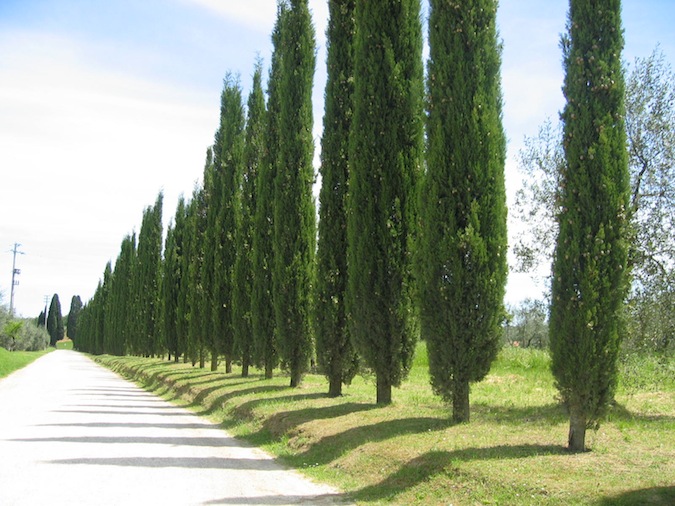
Each of our featured wines for the evening was made from 100% Sangiovese, the signature grape of Tuscany, whose name is derived from the Latin sanguis Jovis, or "the blood of Jove," the Roman king of the gods. Sangiovese and its many clones are the primary ingredient in many of the red wines of Tuscany including Brunello di Montalcino, Morellino di Scansano and many of the Super Tuscans. All of the wines were also from the 2008 vintage, an inconsistent vintage in Tuscany that favored specific producers who were able to adapt to the changing weather conditions. Fèlsina's wines definitely shine and while very approachable now will benefit from additional bottle aging.Each of these wines also clearly represented a different incarnation of the Sangiovese grape and reflected it's own unique terroir. The first two wines of the night were from the Chianto Classico DOCG (Denominazione di Origine Controllata e Garantita). DOCG is Italy's most prestigious and stringent classification, indicating the wine's producer followed the strictest regulations defined by the classification system. Our third wine, the Fontalloro, is a "Super Tuscan" classified as IGT (Indicazione Geografica Tipica) an appellation created in 1992 for wines that were considered to be of higher quality than simple table wines, but which did not conform to the strict wine laws of the region's DOC or DOCG classifications. Before the IGT classification was created, "Super Tuscan" wines such as Fontalloro and Tignanello were labeled Vino da Tavola (VDT), the lowest of the Italian classifications. The evening began with the 2008 Fèlsina Chianti Classico Riserva DOCG featuring grapes grown on a variety of soil types at altitudes ranging from 960 to 1,260 feet above sea level. In the glass this wine is a brilliant ruby red with fragrant aromatics of ripe red fruit with a hint of spice. On the palate, juicy notes of Morello cherry, pomegranate and licorice were accompanied by a lovely minerality, acidity and well integrated tannins. Chef Lenore prepared a lovely platter of Italian delicacies to pair with this wine including chunks of Parmigiano-Reggiano cheese, mozzarella wrapped in Prosciutto di Parma and dried figs. The tannins of the wine interacted deliciously with the flavors and textures of the food. Wine Advocate: 91+ points. Wine Atelier price: $27
The evening began with the 2008 Fèlsina Chianti Classico Riserva DOCG featuring grapes grown on a variety of soil types at altitudes ranging from 960 to 1,260 feet above sea level. In the glass this wine is a brilliant ruby red with fragrant aromatics of ripe red fruit with a hint of spice. On the palate, juicy notes of Morello cherry, pomegranate and licorice were accompanied by a lovely minerality, acidity and well integrated tannins. Chef Lenore prepared a lovely platter of Italian delicacies to pair with this wine including chunks of Parmigiano-Reggiano cheese, mozzarella wrapped in Prosciutto di Parma and dried figs. The tannins of the wine interacted deliciously with the flavors and textures of the food. Wine Advocate: 91+ points. Wine Atelier price: $27 Our second wine of the evening was the 2008 Fèlsina "Rancia" Chianti Classico Riserva DOCG, which takes its name from the historic Rancia estate that was once a Benedictine monastery. This vineyard consists of 15 acres with limestone and marl soils and elevations ranging between 1,200 and 1,260 feet with a southwest exposure. The first vintage of the “Rancia” single vineyard Chianti Classico Riserva was produced in 1983. This wine is deep ruby red in color with aromas of red and black fruit and spice. On the palate, classic notes of the characteristic Morello cherry, blackberry, black tea and earth are accompanied by firm yet supple tannins and a delightfully long, lingering finish. This Tuscan beauty paired very well with Chef Lenore's riff on Pasta Bolognese featuring the addition of red currants which really highlighted these nuances in the wine. Wine Advocate: 93+ points. Wine Atelier price: $44
Our second wine of the evening was the 2008 Fèlsina "Rancia" Chianti Classico Riserva DOCG, which takes its name from the historic Rancia estate that was once a Benedictine monastery. This vineyard consists of 15 acres with limestone and marl soils and elevations ranging between 1,200 and 1,260 feet with a southwest exposure. The first vintage of the “Rancia” single vineyard Chianti Classico Riserva was produced in 1983. This wine is deep ruby red in color with aromas of red and black fruit and spice. On the palate, classic notes of the characteristic Morello cherry, blackberry, black tea and earth are accompanied by firm yet supple tannins and a delightfully long, lingering finish. This Tuscan beauty paired very well with Chef Lenore's riff on Pasta Bolognese featuring the addition of red currants which really highlighted these nuances in the wine. Wine Advocate: 93+ points. Wine Atelier price: $44 Our third wine of the evening was the 2008 Fèlsina Fontalloro, our Super Tuscan of the evening. This special wine is considered the most representative expression of Fèlsina’s Sangiovese since the grapes are grown in vineyards straddling the borders between the Chianti Classico and Chianti Colli Senesi appellations. The vineyards found within the Chianti Classico appellation are in the elevated area of Fèlsina and those of the Chianti Colli Senesi in the lowlands. Like the Rancia, the first vintage of this wine was also 1983. This 100% Sangiovese is aged in first or second use, 225-liter oak barrels for 18-22 months, blended in steel tanks, then bottle-aged for an additional 8-12 months. It also has a deep ruby red color with complex aromas of violet, black currant, earth and licorice. The palate shows good consistency with firm yet approachable tannins, great structure and complexity and a memorable finish. The Fontalloro paired divinely with Chef Lenore's Classic Italian Meatball with Ricotta Cheese. Wine Advocate: 94 points. Wine Atelier price: $54Big thanks to Chiara Leonini from Fattoria di Fèlsina and Stacole Fine Wines for sponsoring our event - everyone truly enjoyed their evening "Under the Tuscan Sun"! To purchase these wines from The Wine Atelier, please click here. Please join us on Thursday, April 25th for "An Evening of Breaking All the Rules with Napa Valley's Art + Farm!". We are fortunate to have Owner/Winemaker Kat McDonald joining us to share her story and her unique approach to winemaking. We are thrilled to welcome her to South Florida! For more details please click here.Cheers,
Our third wine of the evening was the 2008 Fèlsina Fontalloro, our Super Tuscan of the evening. This special wine is considered the most representative expression of Fèlsina’s Sangiovese since the grapes are grown in vineyards straddling the borders between the Chianti Classico and Chianti Colli Senesi appellations. The vineyards found within the Chianti Classico appellation are in the elevated area of Fèlsina and those of the Chianti Colli Senesi in the lowlands. Like the Rancia, the first vintage of this wine was also 1983. This 100% Sangiovese is aged in first or second use, 225-liter oak barrels for 18-22 months, blended in steel tanks, then bottle-aged for an additional 8-12 months. It also has a deep ruby red color with complex aromas of violet, black currant, earth and licorice. The palate shows good consistency with firm yet approachable tannins, great structure and complexity and a memorable finish. The Fontalloro paired divinely with Chef Lenore's Classic Italian Meatball with Ricotta Cheese. Wine Advocate: 94 points. Wine Atelier price: $54Big thanks to Chiara Leonini from Fattoria di Fèlsina and Stacole Fine Wines for sponsoring our event - everyone truly enjoyed their evening "Under the Tuscan Sun"! To purchase these wines from The Wine Atelier, please click here. Please join us on Thursday, April 25th for "An Evening of Breaking All the Rules with Napa Valley's Art + Farm!". We are fortunate to have Owner/Winemaker Kat McDonald joining us to share her story and her unique approach to winemaking. We are thrilled to welcome her to South Florida! For more details please click here.Cheers,

Last month’s installment of “The Art of Wine & Food” featured the wines of Tuscany, one of Italy’s, and apparently South Florida’s, most beloved wine regions. To showcase this region we were fortunate to be able to feature the wines of one of my favorite producers, Fattoria di Fèlsina.
My husband and I had the pleasure of visiting Fèlsina years ago, located in Castelnuovo Berardegna in the southeastern part of the Chianti Classico appellation northeast of Siena. We had a wonderful experience and have been big fans and collectors of their age-worthy wines ever since.
For our event at the Museum, we were able to feature three of Fèlsina’s wines and each wine was paired with a delicious dish created by Chef Lenore Nolan-Ryan, a true Mistress of Flavors, who also happens to be a true pleasure to work with! Lenore also has a wonderful cooking school and catering company in Ft. Lauderdale, to check it out, please click here.

Each of our featured wines for the evening was made from 100% Sangiovese, the signature grape of Tuscany, whose name is derived from the Latin sanguis Jovis, or “the blood of Jove,” the Roman king of the gods. Sangiovese and its many clones are the primary ingredient in many of the red wines of Tuscany including Brunello di Montalcino, Morellino di Scansano and many of the Super Tuscans. All of the wines were also from the 2008 vintage, an inconsistent vintage in Tuscany that favored specific producers who were able to adapt to the changing weather conditions. Fèlsina’s wines definitely shine and while very approachable now will benefit from additional bottle aging.
Each of these wines also clearly represented a different incarnation of the Sangiovese grape and reflected it’s own unique terroir. The first two wines of the night were from the Chianto Classico DOCG (Denominazione di Origine Controllata e Garantita). DOCG is Italy’s most prestigious and stringent classification, indicating the wine’s producer followed the strictest regulations defined by the classification system. Our third wine, the Fontalloro, is a “Super Tuscan” classified as IGT (Indicazione Geografica Tipica) an appellation created in 1992 for wines that were considered to be of higher quality than simple table wines, but which did not conform to the strict wine laws of the region’s DOC or DOCG classifications. Before the IGT classification was created, “Super Tuscan” wines such as Fontalloro and Tignanello were labeled Vino da Tavola (VDT), the lowest of the Italian classifications.
 The evening began with the 2008 Fèlsina Chianti Classico Riserva DOCG featuring grapes grown on a variety of soil types at altitudes ranging from 960 to 1,260 feet above sea level. In the glass this wine is a brilliant ruby red with fragrant aromatics of ripe red fruit with a hint of spice. On the palate, juicy notes of Morello cherry, pomegranate and licorice were accompanied by a lovely minerality, acidity and well integrated tannins. Chef Lenore prepared a lovely platter of Italian delicacies to pair with this wine including chunks of Parmigiano-Reggiano cheese, mozzarella wrapped in Prosciutto di Parma and dried figs. The tannins of the wine interacted deliciously with the flavors and textures of the food. Wine Advocate: 91+ points. Wine Atelier price: $27
The evening began with the 2008 Fèlsina Chianti Classico Riserva DOCG featuring grapes grown on a variety of soil types at altitudes ranging from 960 to 1,260 feet above sea level. In the glass this wine is a brilliant ruby red with fragrant aromatics of ripe red fruit with a hint of spice. On the palate, juicy notes of Morello cherry, pomegranate and licorice were accompanied by a lovely minerality, acidity and well integrated tannins. Chef Lenore prepared a lovely platter of Italian delicacies to pair with this wine including chunks of Parmigiano-Reggiano cheese, mozzarella wrapped in Prosciutto di Parma and dried figs. The tannins of the wine interacted deliciously with the flavors and textures of the food. Wine Advocate: 91+ points. Wine Atelier price: $27
 Our second wine of the evening was the 2008 Fèlsina “Rancia” Chianti Classico Riserva DOCG, which takes its name from the historic Rancia estate that was once a Benedictine monastery. This vineyard consists of 15 acres with limestone and marl soils and elevations ranging between 1,200 and 1,260 feet with a southwest exposure. The first vintage of the “Rancia” single vineyard Chianti Classico Riserva was produced in 1983. This wine is deep ruby red in color with aromas of red and black fruit and spice. On the palate, classic notes of the characteristic Morello cherry, blackberry, black tea and earth are accompanied by firm yet supple tannins and a delightfully long, lingering finish. This Tuscan beauty paired very well with Chef Lenore’s riff on Pasta Bolognese featuring the addition of red currants which really highlighted these nuances in the wine. Wine Advocate: 93+ points. Wine Atelier price: $44
Our second wine of the evening was the 2008 Fèlsina “Rancia” Chianti Classico Riserva DOCG, which takes its name from the historic Rancia estate that was once a Benedictine monastery. This vineyard consists of 15 acres with limestone and marl soils and elevations ranging between 1,200 and 1,260 feet with a southwest exposure. The first vintage of the “Rancia” single vineyard Chianti Classico Riserva was produced in 1983. This wine is deep ruby red in color with aromas of red and black fruit and spice. On the palate, classic notes of the characteristic Morello cherry, blackberry, black tea and earth are accompanied by firm yet supple tannins and a delightfully long, lingering finish. This Tuscan beauty paired very well with Chef Lenore’s riff on Pasta Bolognese featuring the addition of red currants which really highlighted these nuances in the wine. Wine Advocate: 93+ points. Wine Atelier price: $44
 Our third wine of the evening was the 2008 Fèlsina Fontalloro, our Super Tuscan of the evening. This special wine is considered the most representative expression of Fèlsina’s Sangiovese since the grapes are grown in vineyards straddling the borders between the Chianti Classico and Chianti Colli Senesi appellations. The vineyards found within the Chianti Classico appellation are in the elevated area of Fèlsina and those of the Chianti Colli Senesi in the lowlands. Like the Rancia, the first vintage of this wine was also 1983. This 100% Sangiovese is aged in first or second use, 225-liter oak barrels for 18-22 months, blended in steel tanks, then bottle-aged for an additional 8-12 months. It also has a deep ruby red color with complex aromas of violet, black currant, earth and licorice. The palate shows good consistency with firm yet approachable tannins, great structure and complexity and a memorable finish. The Fontalloro paired divinely with Chef Lenore’s Classic Italian Meatball with Ricotta Cheese. Wine Advocate: 94 points. Wine Atelier price: $54
Our third wine of the evening was the 2008 Fèlsina Fontalloro, our Super Tuscan of the evening. This special wine is considered the most representative expression of Fèlsina’s Sangiovese since the grapes are grown in vineyards straddling the borders between the Chianti Classico and Chianti Colli Senesi appellations. The vineyards found within the Chianti Classico appellation are in the elevated area of Fèlsina and those of the Chianti Colli Senesi in the lowlands. Like the Rancia, the first vintage of this wine was also 1983. This 100% Sangiovese is aged in first or second use, 225-liter oak barrels for 18-22 months, blended in steel tanks, then bottle-aged for an additional 8-12 months. It also has a deep ruby red color with complex aromas of violet, black currant, earth and licorice. The palate shows good consistency with firm yet approachable tannins, great structure and complexity and a memorable finish. The Fontalloro paired divinely with Chef Lenore’s Classic Italian Meatball with Ricotta Cheese. Wine Advocate: 94 points. Wine Atelier price: $54
Big thanks to Chiara Leonini from Fattoria di Fèlsina and Stacole Fine Wines for sponsoring our event – everyone truly enjoyed their evening “Under the Tuscan Sun”! To purchase these wines from The Wine Atelier, please click here. Please join us on Thursday, April 25th for “An Evening of Breaking All the Rules with Napa Valley’s Art + Farm!”. We are fortunate to have Owner/Winemaker Kat McDonald joining us to share her story and her unique approach to winemaking. We are thrilled to welcome her to South Florida! For more details please click here.
Cheers,
![]()
Before embarking on a two week exploration of some of France's renowned wine regions, Steve and I spent a few fabulous days in Paris. From food and wine to art and fashion this city definitely has it all! So what to do in this veritable cultural wonderland with only a few short days and so many options? Here's a few of our postcards from "The City of Light."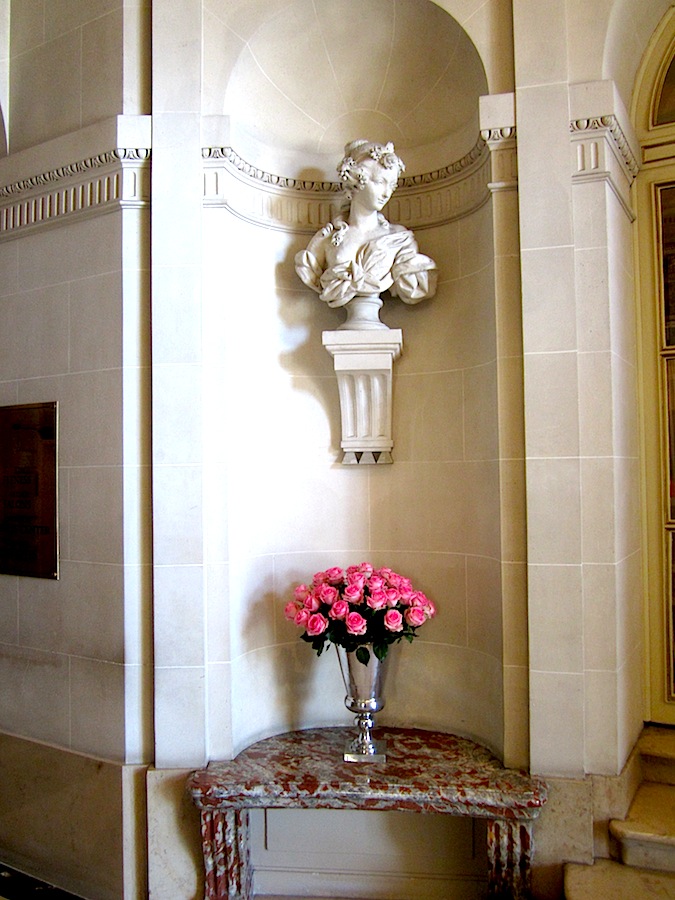
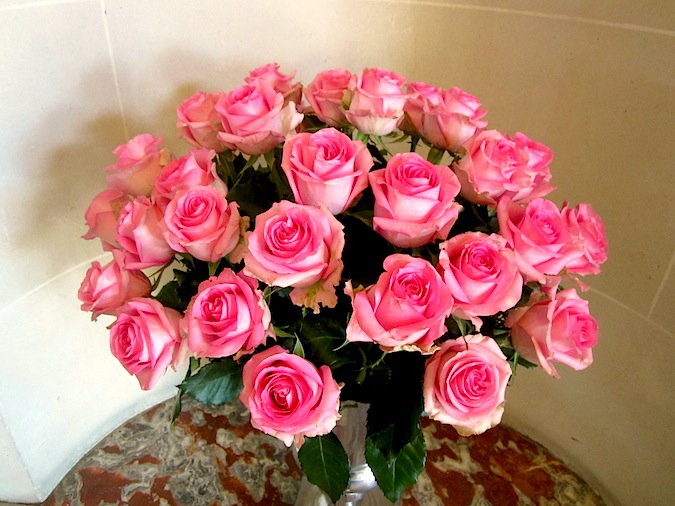 This trip we stayed at the historic Hôtel de Crillon, one of Paris's six Palace Hotels, located on Place de la Concorde. Constructed in 1758, this hotel is situated in the center of Paris, a great location from which to explore this fabulous city. Directly in front of the hotel is the Place de la Concorde, one of the largest squares in Paris, conveniently situated between the Tuileries and the Champs Elyseés. The square is home to the majestic Luxor Obelisk which was originally located at the entrance to the Luxor Temple in Egypt. The structure was gifted to the French in the 19th century and in 1836, King Louis Philippe had it placed where the guillotine once stood during the Revolution. It is flanked by two beautiful, ornate fountains, the Fontaines de la Concorde. The square also provides a beautiful view of the Eiffel Tower at night which I am happy to share with you in the short video below!After arriving at our hotel from the airport on a Sunday morning, we sunk into sumptuous, cozy chairs in the gorgeously appointed lobby to enjoy to enjoy a glass (or two) of Champagne and some delicious pastries including my favorite, pain au chocolat. Shortly after we headed for the Boulevard Raspail Market located in Paris's 6th arrondissement. The market is open three days a week and on Sunday becomes one of the city's marché biologiques, or organic markets, which extends from the Rue de Cherche-Midi to Rue de Rennes. The market featured beautiful stalls of fresh produce, delicious meats, fragrant cheeses and brilliantly colored flowers - it was truly a feast for the senses!
This trip we stayed at the historic Hôtel de Crillon, one of Paris's six Palace Hotels, located on Place de la Concorde. Constructed in 1758, this hotel is situated in the center of Paris, a great location from which to explore this fabulous city. Directly in front of the hotel is the Place de la Concorde, one of the largest squares in Paris, conveniently situated between the Tuileries and the Champs Elyseés. The square is home to the majestic Luxor Obelisk which was originally located at the entrance to the Luxor Temple in Egypt. The structure was gifted to the French in the 19th century and in 1836, King Louis Philippe had it placed where the guillotine once stood during the Revolution. It is flanked by two beautiful, ornate fountains, the Fontaines de la Concorde. The square also provides a beautiful view of the Eiffel Tower at night which I am happy to share with you in the short video below!After arriving at our hotel from the airport on a Sunday morning, we sunk into sumptuous, cozy chairs in the gorgeously appointed lobby to enjoy to enjoy a glass (or two) of Champagne and some delicious pastries including my favorite, pain au chocolat. Shortly after we headed for the Boulevard Raspail Market located in Paris's 6th arrondissement. The market is open three days a week and on Sunday becomes one of the city's marché biologiques, or organic markets, which extends from the Rue de Cherche-Midi to Rue de Rennes. The market featured beautiful stalls of fresh produce, delicious meats, fragrant cheeses and brilliantly colored flowers - it was truly a feast for the senses!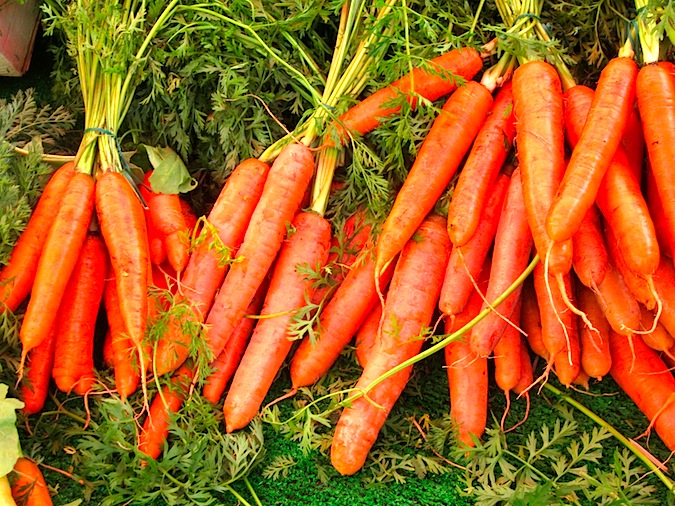
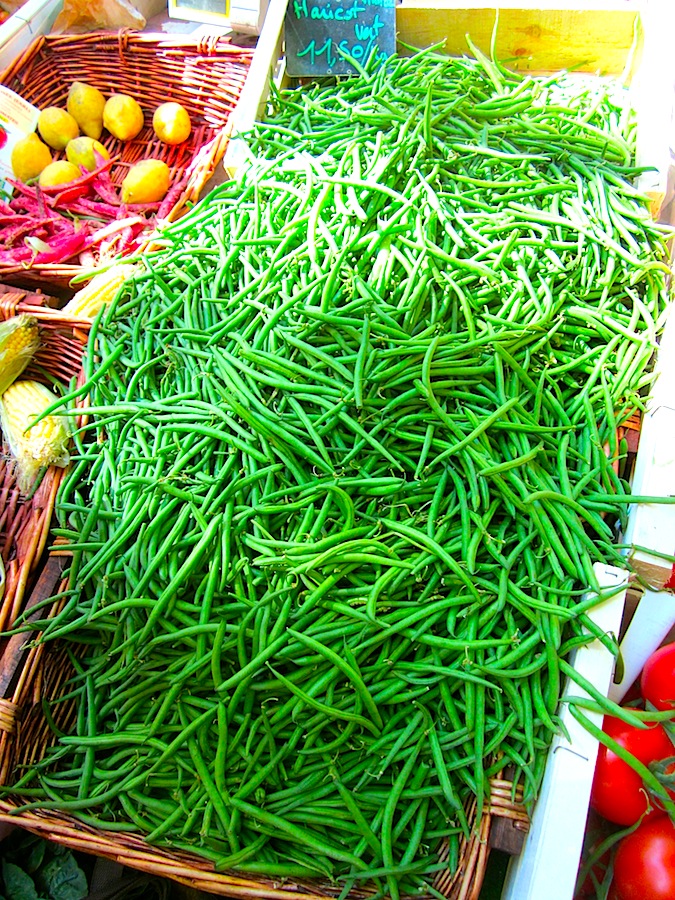
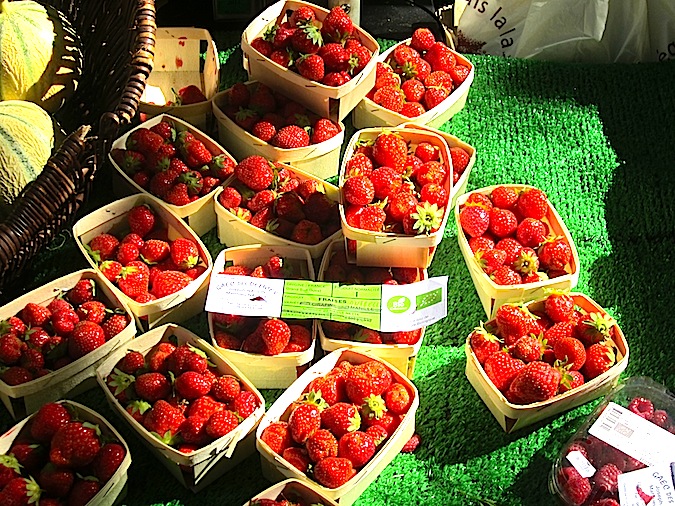

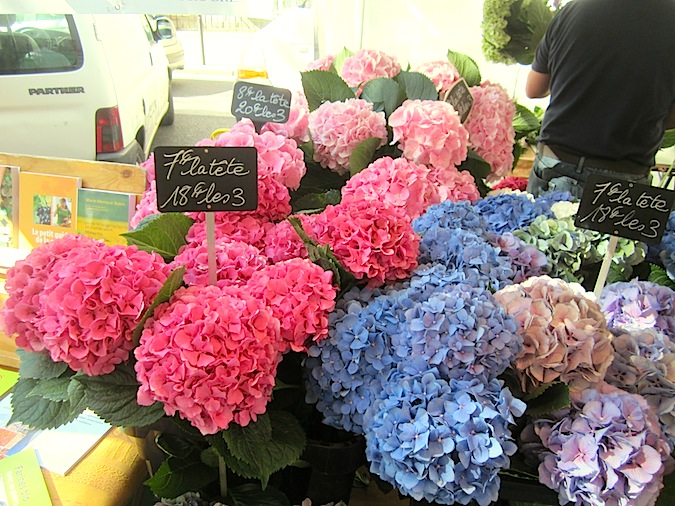 After the market we meandered through Saint-Germain-des-Prés, the charming neighborhood that lines the Left Bank of the Seine and is home to many storied cafés and brasseries including Cafe de Flore (a personal favorite!), Les Deux Magots and Brasserie Lipp. You'll also find an array of specialty food stores including Poilâne, arguably the best bread in Paris, as well as Pierre Hermé, home to mouth-wateringly beautiful confections including delightful mille feuilles, a rainbow of macarons and decadent chocolates.
After the market we meandered through Saint-Germain-des-Prés, the charming neighborhood that lines the Left Bank of the Seine and is home to many storied cafés and brasseries including Cafe de Flore (a personal favorite!), Les Deux Magots and Brasserie Lipp. You'll also find an array of specialty food stores including Poilâne, arguably the best bread in Paris, as well as Pierre Hermé, home to mouth-wateringly beautiful confections including delightful mille feuilles, a rainbow of macarons and decadent chocolates.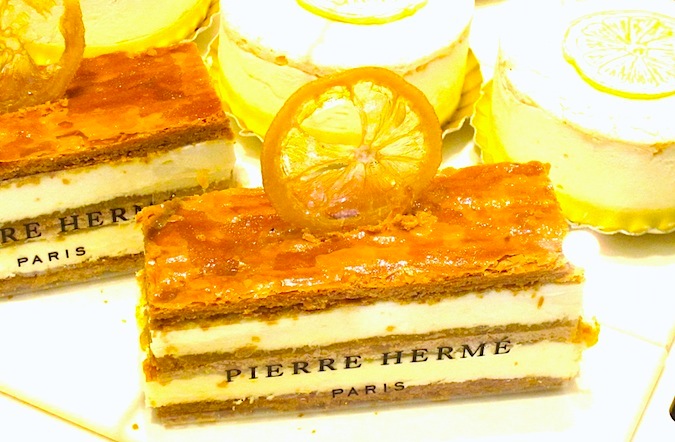
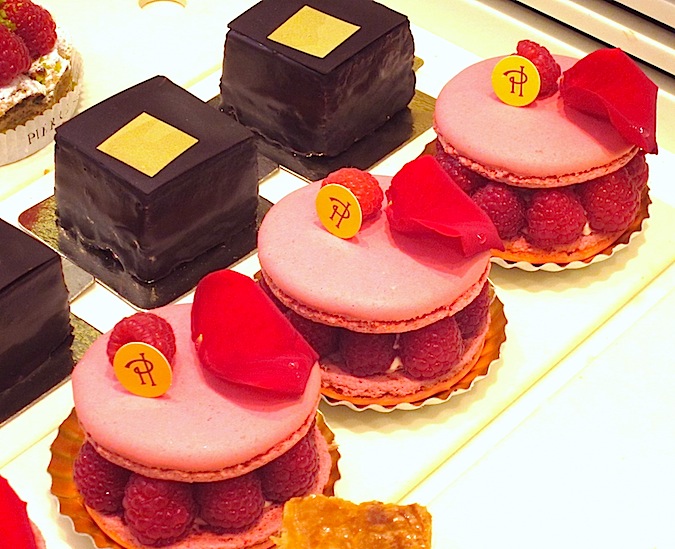
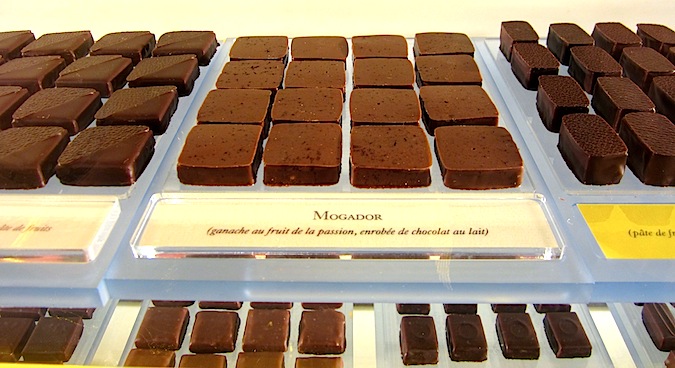 When planning our itinerary for this trip, I was very inspired by one of my new favorite movies, Midnight in Paris, written and directed by Woody Allen and starring Owen Wilson and Rachel McAdams. This movie is a MUST for any Francophile and/or lover of Art History, Literature or Music! I particularly loved the scene at Polidor where Owen Wilson's character first meets Ernest Hemingway and we were able to find it on Rue Monsieur-le-Prince during our walk - it actually looks alot like it does in the movie.
When planning our itinerary for this trip, I was very inspired by one of my new favorite movies, Midnight in Paris, written and directed by Woody Allen and starring Owen Wilson and Rachel McAdams. This movie is a MUST for any Francophile and/or lover of Art History, Literature or Music! I particularly loved the scene at Polidor where Owen Wilson's character first meets Ernest Hemingway and we were able to find it on Rue Monsieur-le-Prince during our walk - it actually looks alot like it does in the movie.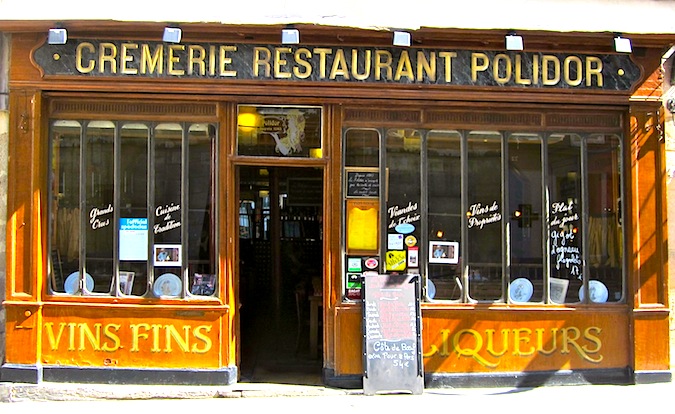 After a mid-afternoon nap, we headed out that evening for a little more exploring and luckily, we didn't have to go far to find another great location from Midnight in Paris - Maxim's was right around the corner from our hotel! Maxim's is an historic Paris eatery established in 1893 which is known for its Art Nouveau decor and reputation for its world class cuisine and famous clientele. Maxim's attracted a slew of celebrities over the years including Jean Cocteau, Aristotle Onassis, Edward VIII and his wife Wallis Simpson as well as Brigitte Bardot, who caused a scandal in the 1970's when she entered the restaurant in her bare feet. In Midnight in Paris, Marion Cotillard's character Adriana is smitten with the idea of La Belle Epoque in Paris and Maxim's is one of the places she desperately wants to visit in order to escape the mundane 1920's. I don't know about La Belle Epoque but it was certainly nice to be there in 2012!
After a mid-afternoon nap, we headed out that evening for a little more exploring and luckily, we didn't have to go far to find another great location from Midnight in Paris - Maxim's was right around the corner from our hotel! Maxim's is an historic Paris eatery established in 1893 which is known for its Art Nouveau decor and reputation for its world class cuisine and famous clientele. Maxim's attracted a slew of celebrities over the years including Jean Cocteau, Aristotle Onassis, Edward VIII and his wife Wallis Simpson as well as Brigitte Bardot, who caused a scandal in the 1970's when she entered the restaurant in her bare feet. In Midnight in Paris, Marion Cotillard's character Adriana is smitten with the idea of La Belle Epoque in Paris and Maxim's is one of the places she desperately wants to visit in order to escape the mundane 1920's. I don't know about La Belle Epoque but it was certainly nice to be there in 2012!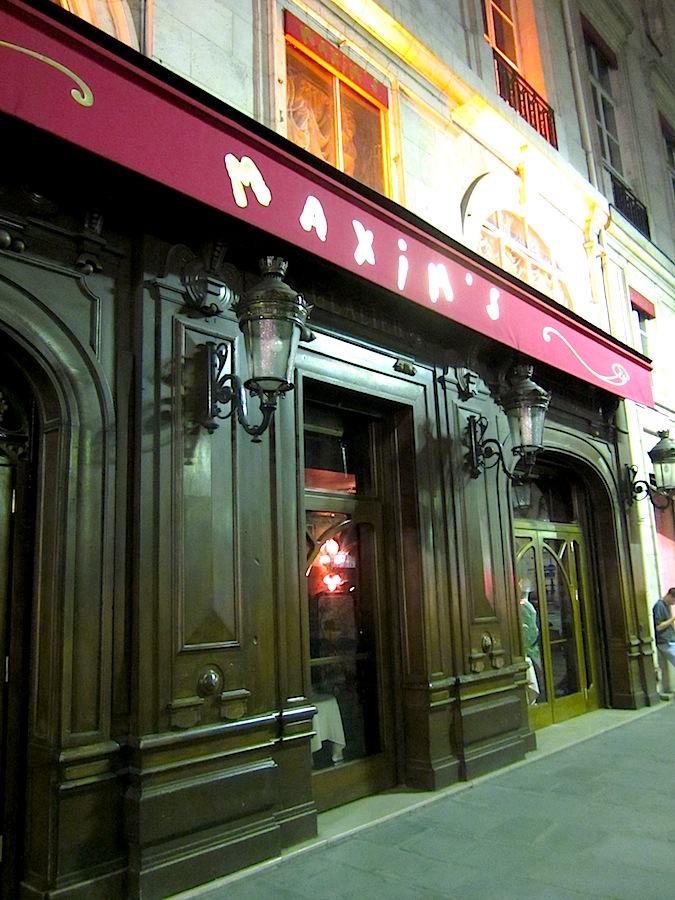 To be continued in Postcards from Paris: Part Deux!Cheers,
To be continued in Postcards from Paris: Part Deux!Cheers,
We began our second day in Paris with breakfast at the hotel in the legendary Les Ambassadeurs dining room. The sumptuous space, formerly the Count of Crillon's ballroom, is replete with gorgeous Baccarat crystal chandeliers, ornate frescoes and polished marble that beautifully embody the Rococo aesthetic. Built in 1758, Les Ambassadeurs has operated as a restaurant within the Hôtel de Crillon since the 19th century. It reached the height of its popularity as a restaurant and night club in the 1870's when it was frequented by the aristocracy and some of the best known figures of the art world. As a result, it has been portrayed in works of art by Edgar Degas and Henri de Toulouse-Lautrec and was also featured in Ernest Hemingway's memoir "A Moveable Feast." In 2011, the restaurant was re-awarded a Michelin star after losing its two star status in 2010 following the departure of Chef Jean-Francois Piege. The very talented Chef Christopher Hache and his team are dedicated to restoring Les Ambassadeurs to its former culinary glory. I have to say they're doing a pretty fabulous job!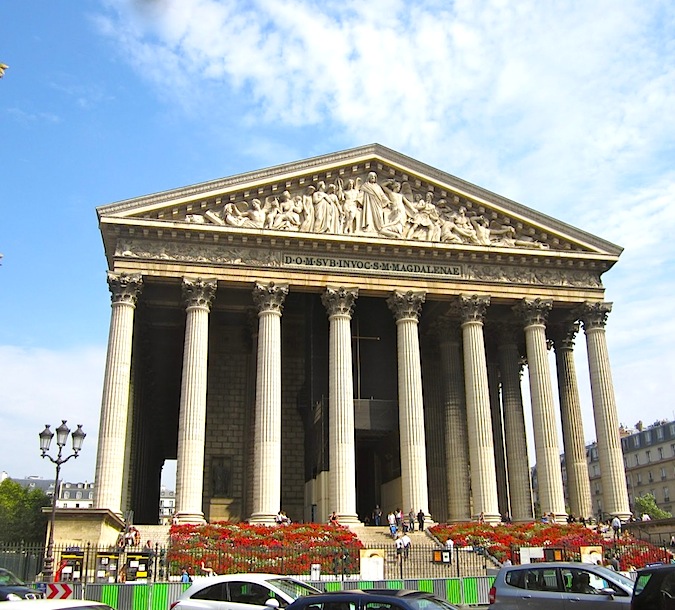 After breakfast we wandered around the city and came across L'eglise de la Madeleine (Church of the Madeleine), a Roman Catholic Church with a long and complicated history. Razed to the ground at three different points during its construction, it was finally built in the Neo-Classical style envisioned by Napoleon who was inspired by the Maison Carée at Nimes, one of the best-preserved Roman temples. Despite Napoleon's plan to have the structure serve as a memorial to the French Army, King Louis XVIII ultimately decided it would serve as a church dedicated to Mary Magdalene which was finally consecrated in 1842.
After breakfast we wandered around the city and came across L'eglise de la Madeleine (Church of the Madeleine), a Roman Catholic Church with a long and complicated history. Razed to the ground at three different points during its construction, it was finally built in the Neo-Classical style envisioned by Napoleon who was inspired by the Maison Carée at Nimes, one of the best-preserved Roman temples. Despite Napoleon's plan to have the structure serve as a memorial to the French Army, King Louis XVIII ultimately decided it would serve as a church dedicated to Mary Magdalene which was finally consecrated in 1842.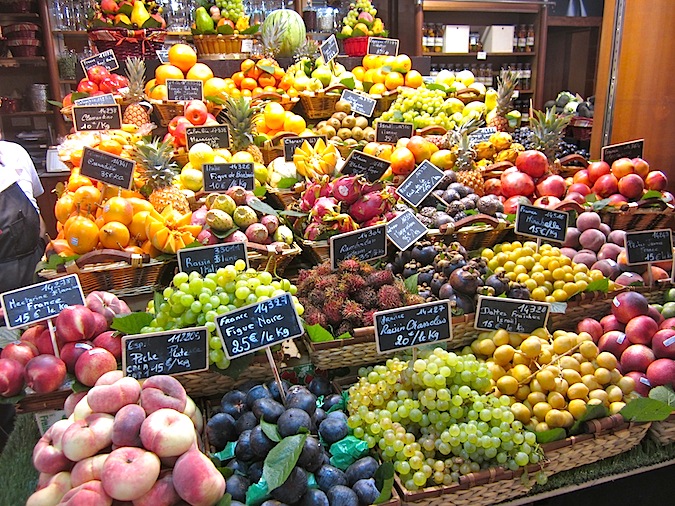
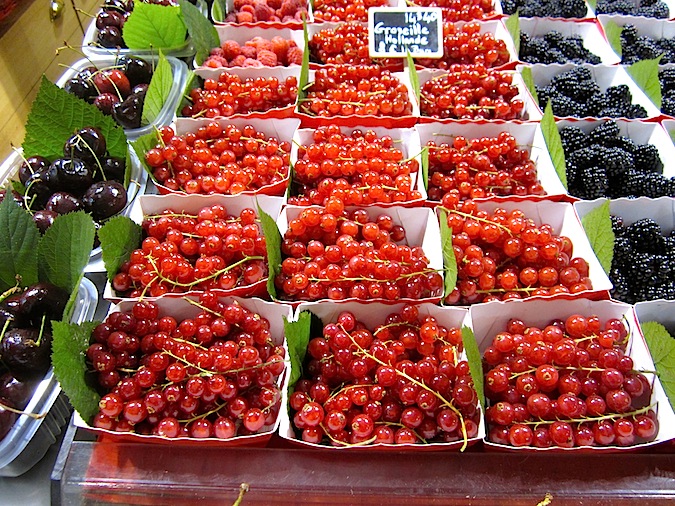 Further down the street on Place de la Madeleine was Hédiard, a fabulous gourmet grocery store featuring beautiful displays of produce, teas, spices and other gourmet specialties. This Parisian gastronomic institution was founded in 1850 by Ferdinand Hédiard and was born out of his love for exotic produce such as lychee, guava and bananas - the likes of which Paris had never seen! This location is Hediard's flagship store and it was from this very place that Hédiard first sold his fabulous produce to the finest restaurants in Paris as well as his loyal customers. He is even credited with providing celebrated artist Eugene Delacroix, a longtime fan, with his first pineapple. The day we were there was actually the first time I had ever seen fresh red currants which looked like beautiful, shiny, ruby red jewels - thanks, Ferdinand!
Further down the street on Place de la Madeleine was Hédiard, a fabulous gourmet grocery store featuring beautiful displays of produce, teas, spices and other gourmet specialties. This Parisian gastronomic institution was founded in 1850 by Ferdinand Hédiard and was born out of his love for exotic produce such as lychee, guava and bananas - the likes of which Paris had never seen! This location is Hediard's flagship store and it was from this very place that Hédiard first sold his fabulous produce to the finest restaurants in Paris as well as his loyal customers. He is even credited with providing celebrated artist Eugene Delacroix, a longtime fan, with his first pineapple. The day we were there was actually the first time I had ever seen fresh red currants which looked like beautiful, shiny, ruby red jewels - thanks, Ferdinand!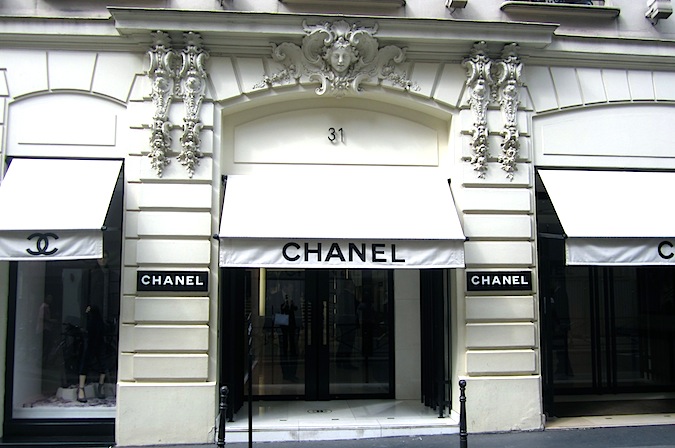
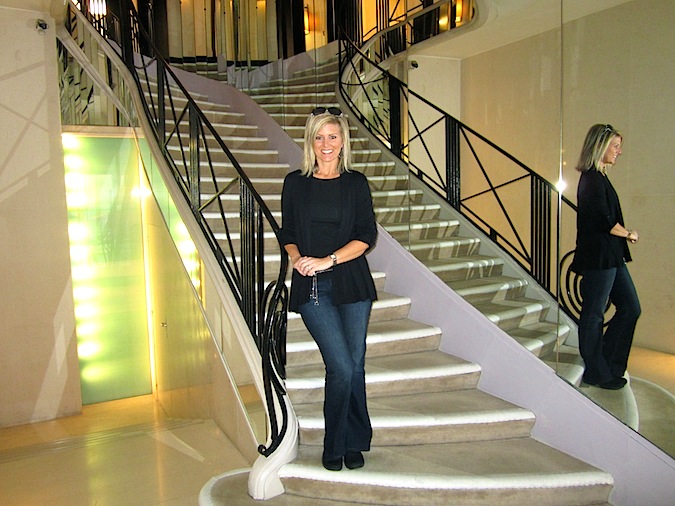
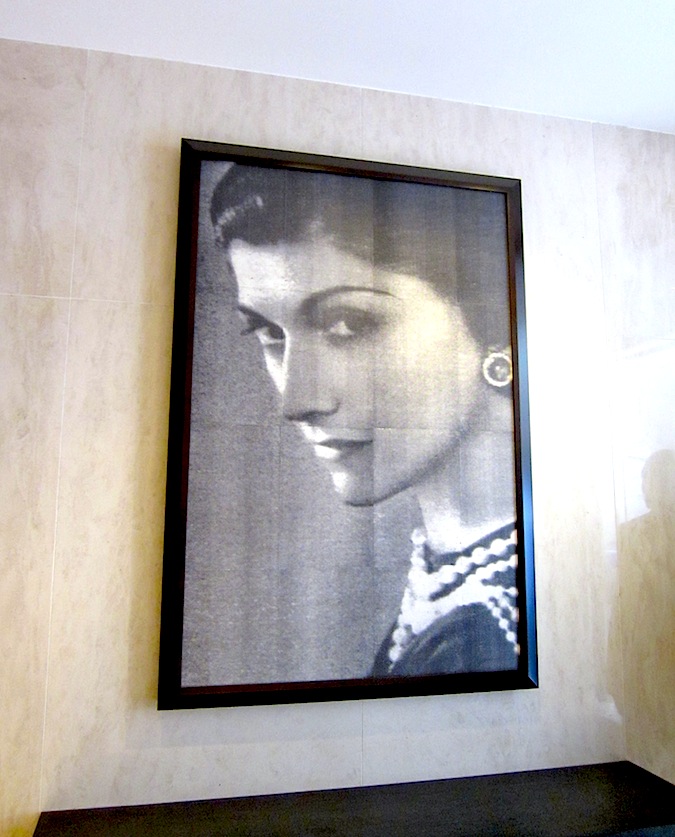 Of course, a trip to Paris just wouldn't be complete without a trip to the mecca of fashion: Chanel! While there are quite a few Chanel stores in Paris, the one located at 31 Rue Cambon holds special meaning because it is also the address of Coco Chanel's apartment which is located directly above the boutique. Mademoiselle Chanel didn't actually live in the apartment (in fact, it doesn't even have a bedroom) choosing instead to live at the nearby Ritz Hotel. Every morning before she crossed Place Vendôme on her way to the Rue Cambon boutique she would call to inform them of her imminent arrival so the staircase of her apartment (pictured above) could be misted with Chanel No. 5. I've been trying to get Steve to do that ever since we've been back but so far no luck. What a way to start the day!
Of course, a trip to Paris just wouldn't be complete without a trip to the mecca of fashion: Chanel! While there are quite a few Chanel stores in Paris, the one located at 31 Rue Cambon holds special meaning because it is also the address of Coco Chanel's apartment which is located directly above the boutique. Mademoiselle Chanel didn't actually live in the apartment (in fact, it doesn't even have a bedroom) choosing instead to live at the nearby Ritz Hotel. Every morning before she crossed Place Vendôme on her way to the Rue Cambon boutique she would call to inform them of her imminent arrival so the staircase of her apartment (pictured above) could be misted with Chanel No. 5. I've been trying to get Steve to do that ever since we've been back but so far no luck. What a way to start the day!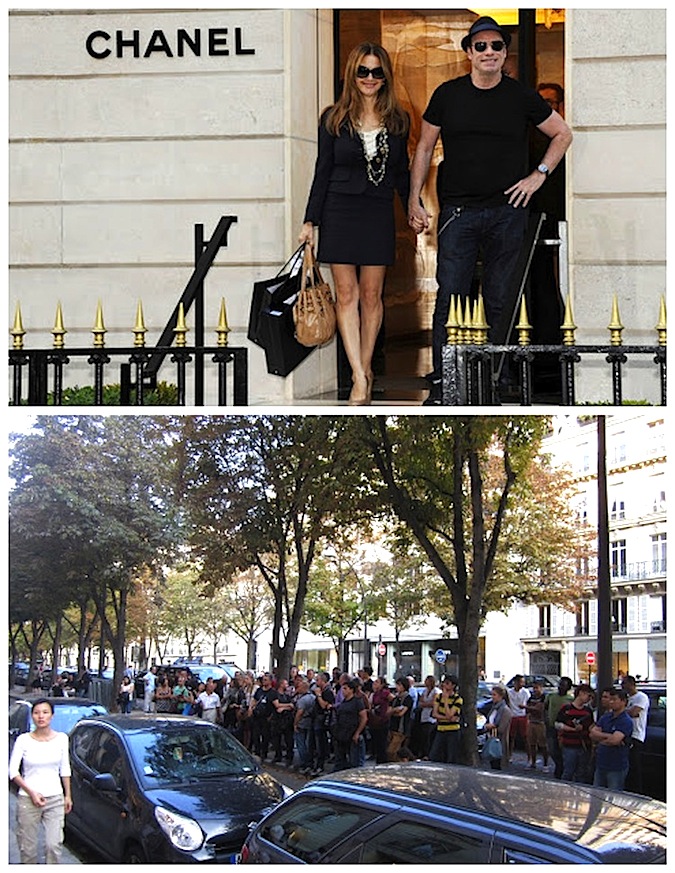 The biggest Chanel buzz during our stay in Paris was the brand new 6,500 square foot Chanel boutique at 51 Avenue Montaigne. This store makes a total of three Chanel boutiques on this revered street alone! The new store was inspired by Coco Chanel's apartment and echoed similar elements including textured screens, sumptuous fabrics and a gorgeous stairway with gilded railings and a cascade of pearls dripping from the ceiling onto the white marble floor below. When we arrived there was a crowd of paparazzi out front who were hoping to catch a glimpse of some other shoppers getting their "Chanel on" that day: John Travolta and Kelly Preston. A flurry of activity surrounded their private fitting room while Chanel associates buzzed in and out with armfuls of stunning merchandise. When the couple left, Kelly was wearing a few beautiful new Chanel necklaces and clutching multiple black bags of fabulousness. If John's trying to make up for something I'd say he's definitely headed in the right direction!
The biggest Chanel buzz during our stay in Paris was the brand new 6,500 square foot Chanel boutique at 51 Avenue Montaigne. This store makes a total of three Chanel boutiques on this revered street alone! The new store was inspired by Coco Chanel's apartment and echoed similar elements including textured screens, sumptuous fabrics and a gorgeous stairway with gilded railings and a cascade of pearls dripping from the ceiling onto the white marble floor below. When we arrived there was a crowd of paparazzi out front who were hoping to catch a glimpse of some other shoppers getting their "Chanel on" that day: John Travolta and Kelly Preston. A flurry of activity surrounded their private fitting room while Chanel associates buzzed in and out with armfuls of stunning merchandise. When the couple left, Kelly was wearing a few beautiful new Chanel necklaces and clutching multiple black bags of fabulousness. If John's trying to make up for something I'd say he's definitely headed in the right direction!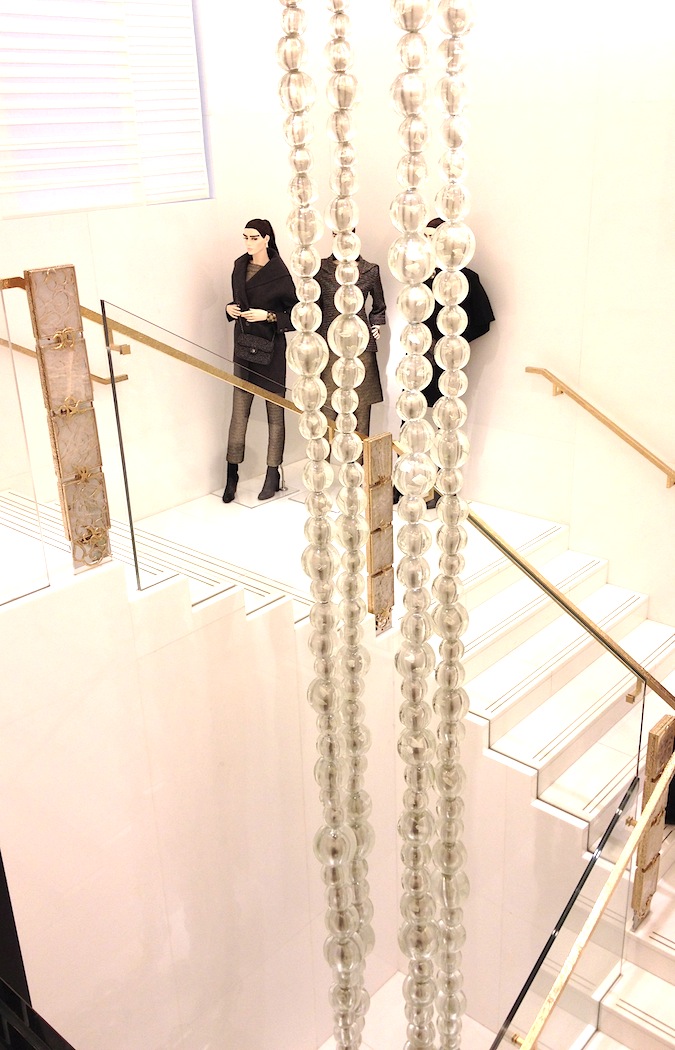
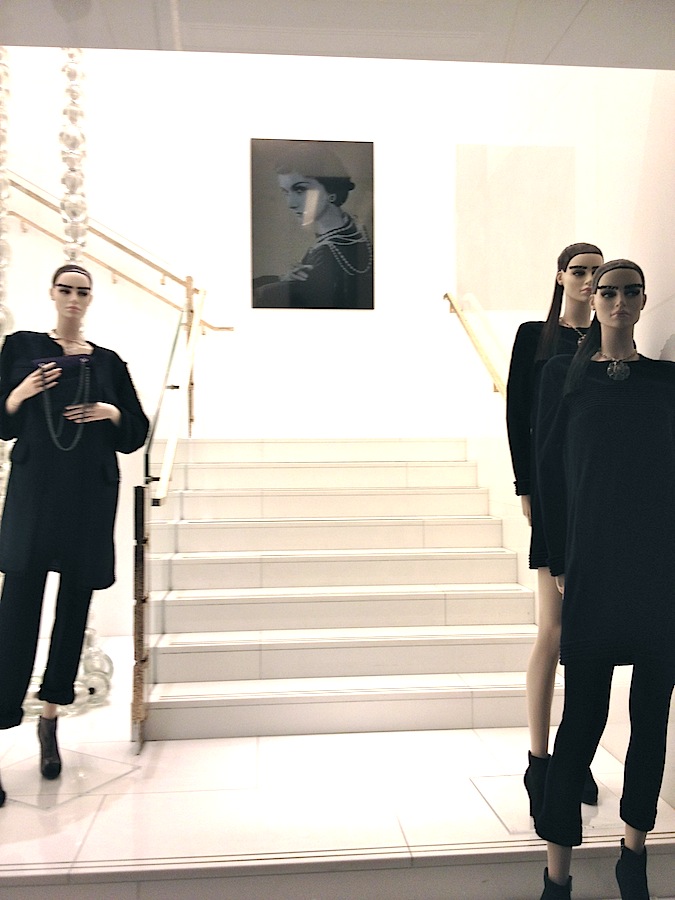 After our Tour de Chanel we visited the Musee de L'Orangerie located in the western end of the Tuileries Gardens. This museum is home to a treasure trove of Impressionist and Post-Impressionist works by artists including Picasso, Matisse, Cezanne, Modigliani and many more. The museum also represents another Midnight in Paris filming location. If you're familiar with the movie, this is where Gil and Inez accompany Paul and Carol for the private showing of Monet's "Water Lilies." Paul, being the pedantic, pseudo-intellectual, Monet expert that he is, proceeds to school the group on the historical significance of Monet's work.
After our Tour de Chanel we visited the Musee de L'Orangerie located in the western end of the Tuileries Gardens. This museum is home to a treasure trove of Impressionist and Post-Impressionist works by artists including Picasso, Matisse, Cezanne, Modigliani and many more. The museum also represents another Midnight in Paris filming location. If you're familiar with the movie, this is where Gil and Inez accompany Paul and Carol for the private showing of Monet's "Water Lilies." Paul, being the pedantic, pseudo-intellectual, Monet expert that he is, proceeds to school the group on the historical significance of Monet's work.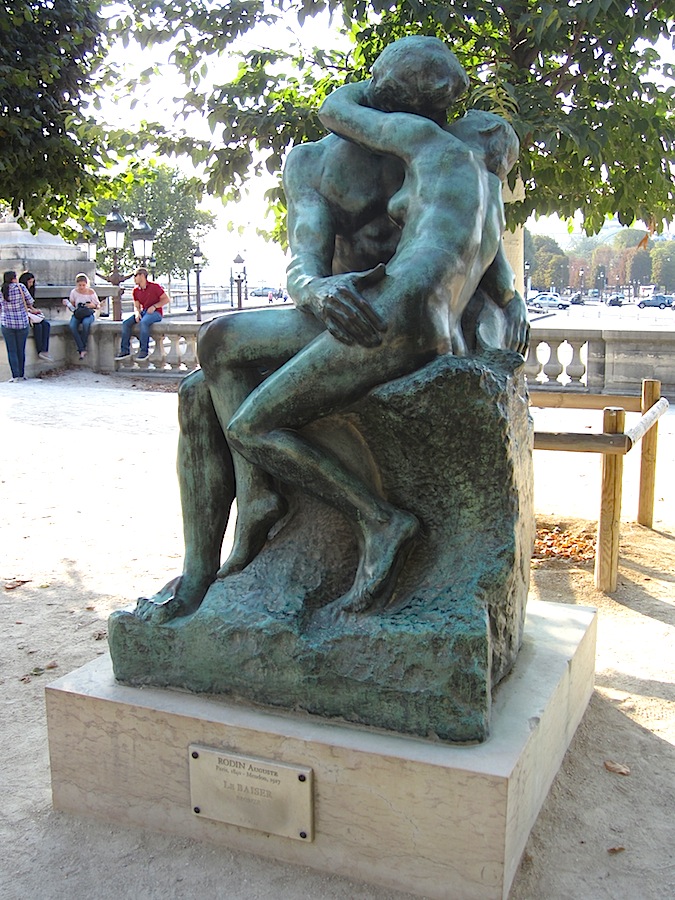 Eight panels of Monet's "Water Lilies", or "Nymphéas" as they are known in France, doreside at L'Orangerie. In 1922 Monet agreed to donate the pieces to the French government with the understanding they would be displayed in specially designed rooms at the museum. However, due to his reluctance to part with them, it wasn't until after his death in 1926 that they were finally installed and displayed for the public. A major renovation took place from 2000-2006 that enabled these historic works to be viewed as Monet had originally intended: under direct diffused natural light. While I was too busy enjoying to take photos of them (sorry!) I did take one of Auguste Rodin's beautiful bronze sculpture "Le Baiser" located on the terrace of the museum.After a busy day exploring Paris we had an early dinner and called it a night before an early train to Champagne the following morning...Cheers,
Eight panels of Monet's "Water Lilies", or "Nymphéas" as they are known in France, doreside at L'Orangerie. In 1922 Monet agreed to donate the pieces to the French government with the understanding they would be displayed in specially designed rooms at the museum. However, due to his reluctance to part with them, it wasn't until after his death in 1926 that they were finally installed and displayed for the public. A major renovation took place from 2000-2006 that enabled these historic works to be viewed as Monet had originally intended: under direct diffused natural light. While I was too busy enjoying to take photos of them (sorry!) I did take one of Auguste Rodin's beautiful bronze sculpture "Le Baiser" located on the terrace of the museum.After a busy day exploring Paris we had an early dinner and called it a night before an early train to Champagne the following morning...Cheers,